Sri Lanka
Sri Lanka is a small island located near India. In geography classes, they sometimes tell the legend that Sri Lanka is a tear that fell from India’s cheek. The island really does resemble a tear in shape.
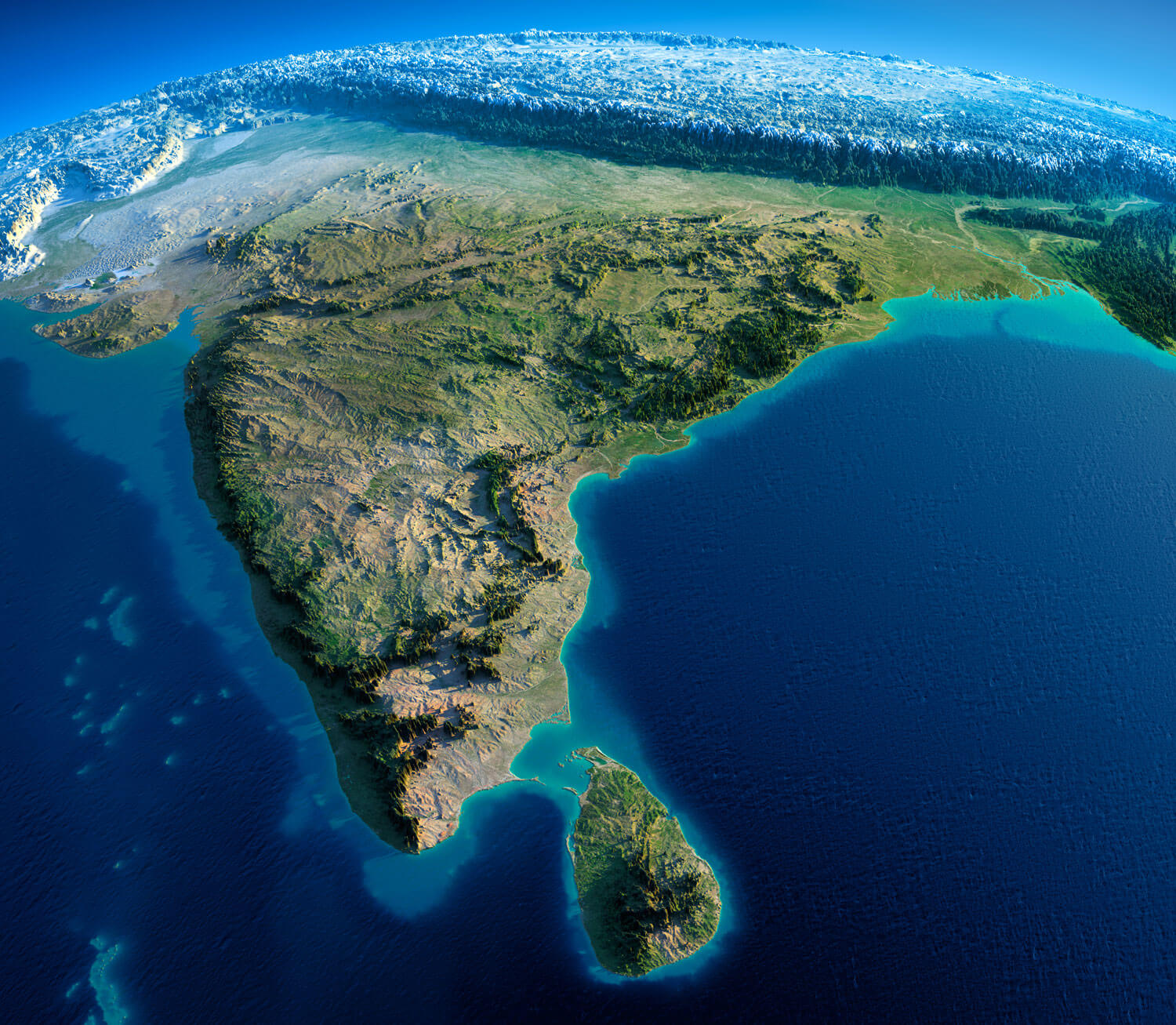
Long ago, Sri Lanka was connected to India by something like a bridge, more precisely, a long and thin limestone shoal. Now, only a chain of islands remains from the bridge, which from space looks like the remnants of a real man-made bridge.
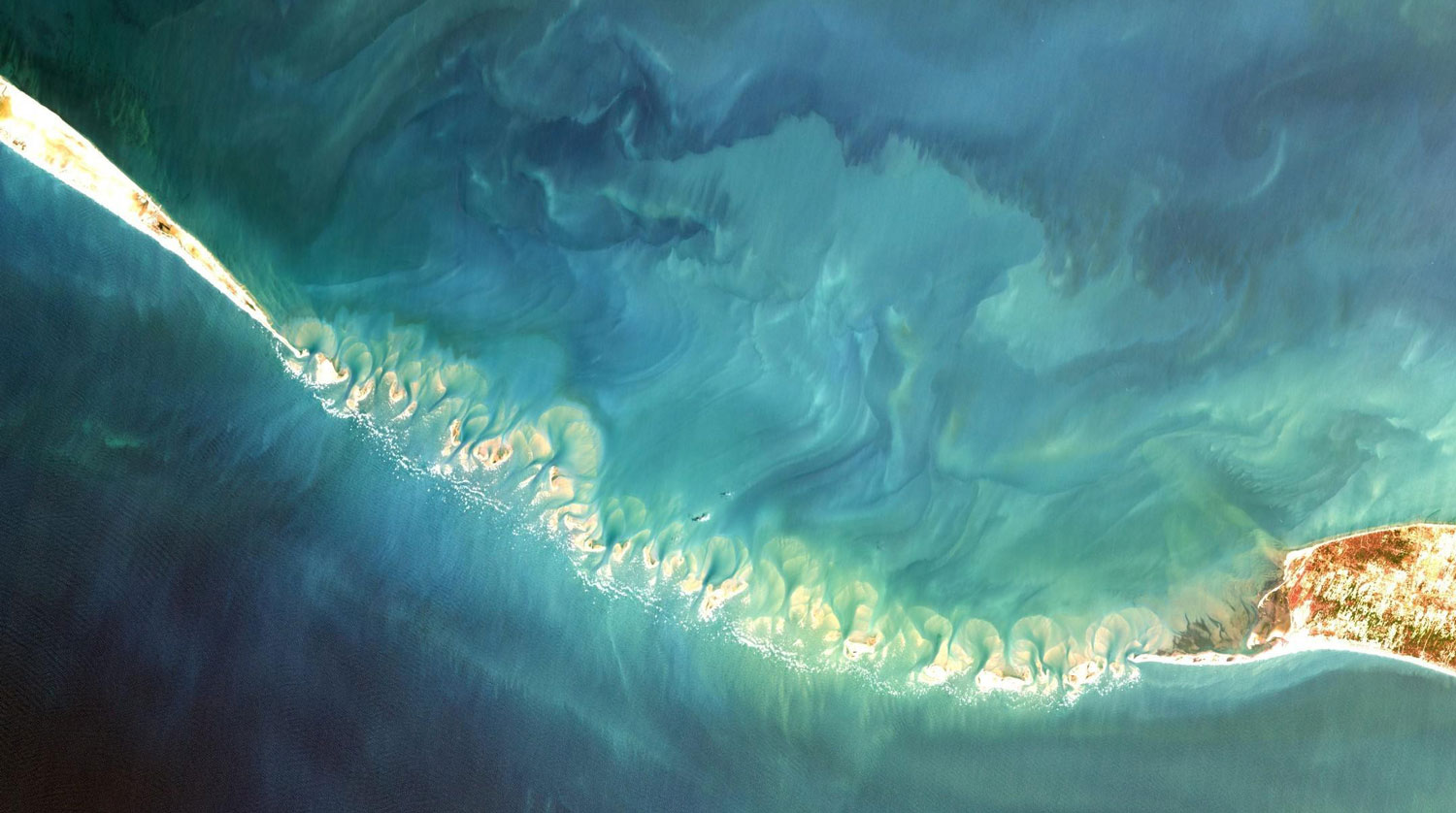
We know from ancient books, mainly religious ones, that these islands were previously connected to each other. For example, from the chronicle found in the Indian temple of Ramanathaswami. This small sanctuary is located right at the beginning of the Sri Lankan bridge. The temple attendants witnessed a powerful storm that literally washed away and submerged the bridge underwater.
Another well-known legend about Sri Lanka comes from Islam. Muslims believe that Allah, after casting the first humans out of paradise onto earth, sent Adam to Sri Lanka. That’s why the mountain in the center of the island is called Adam’s Peak.
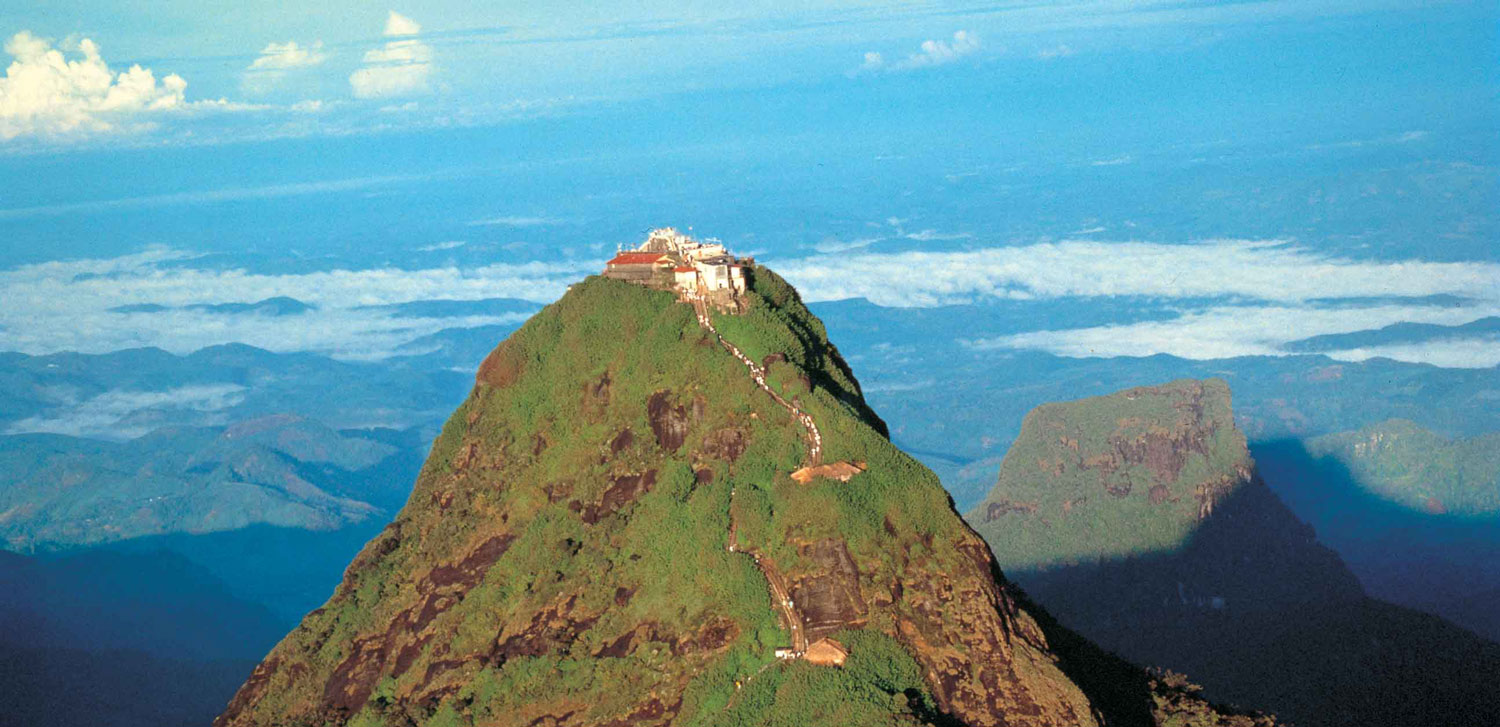
And the isthmus that connected Sri Lanka to India is called Adam’s Bridge. According to the Islamic legend, it was through this bridge that Adam was able to leave the island to meet Eve.
Certainly, these are just legends. But the existence of the bridge is confirmed by geological research. This often happens with religious literature: myths are mixed with real history.
Paradise
During the flight from Qatar to Sri Lanka, I overheard a conversation between two Americans sitting behind me.
“Is this your first time in Sri Lanka?”
“Yes, we decided to change the scenery after quarantine.”
“I’m flying here for the seventh time. I fly every year. Absolutely heavenly place.”
“Seventh time, wow! What do you like the most?”
“Everything. Absolutely everything. Magnificent place. People, beaches, food, sun, ocean. Sri Lanka is heaven on earth.”
Soon I myself became convinced of it.
Villas.
The best beaches in Sri Lanka are located in the village of Hikkaduwa. It is essentially a small village that’s filled with villas that look no worse than American ones.
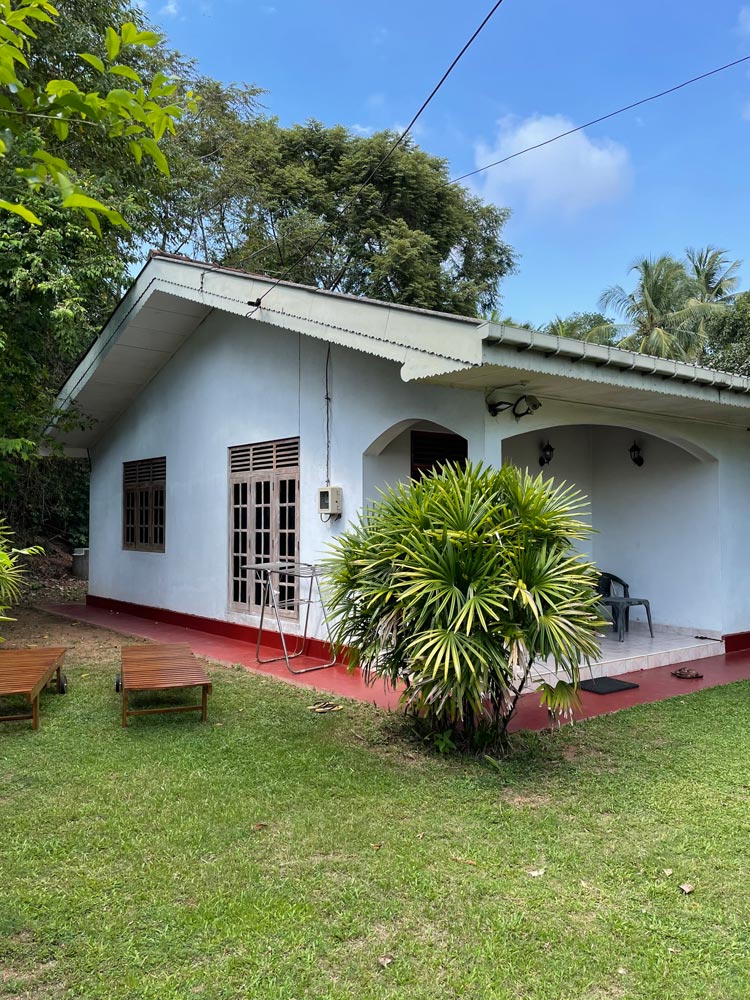
The villas have everything you need: two air-conditioned bedrooms, a toilet and bathroom, a shower, usually a huge kitchen, and a fenced garden with a barbecue area.
The size of the villa can vary greatly: from 50 to 200 square meters for the house, and an equal-sized plot of land.
Such a villa is very affordable by Western standards. The price of a two-bedroom villa with a kitchen and garden 200 meters from the ocean can be as low as $500 per month. For two people, this is absolutely nothing.
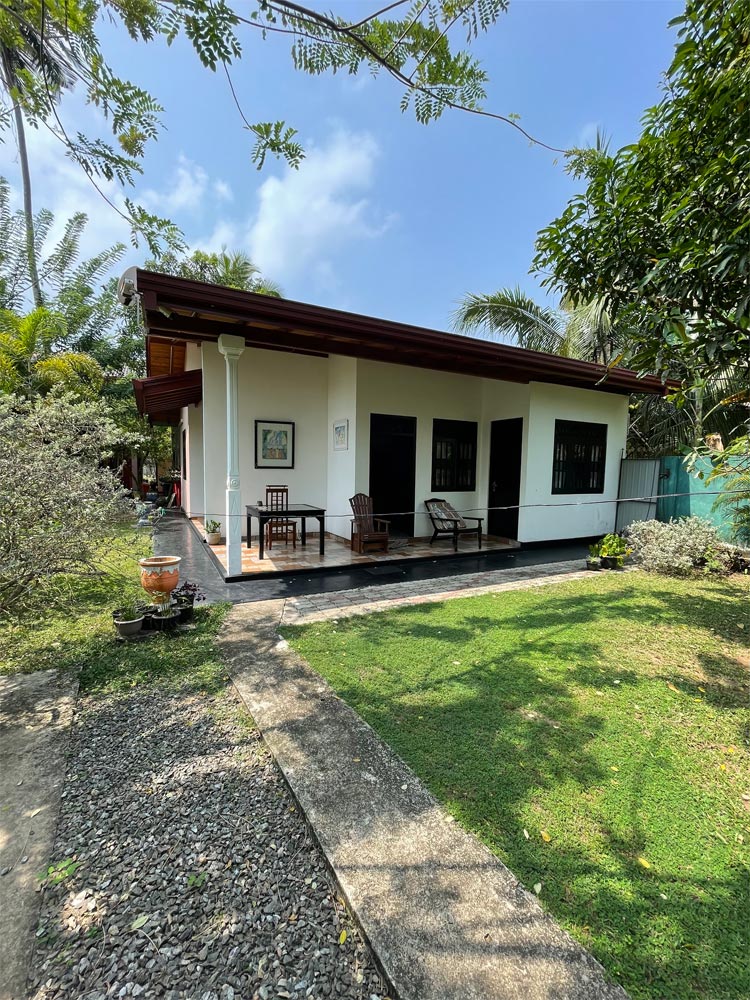
Villas in other resort areas are even cheaper. For example, in the city of Negombo, a two-story villa with three bedrooms, a living room with an electric fountain, two balconies and two bathrooms, as well as a kitchen in a separate building, cost the same $500 per month for two guests.
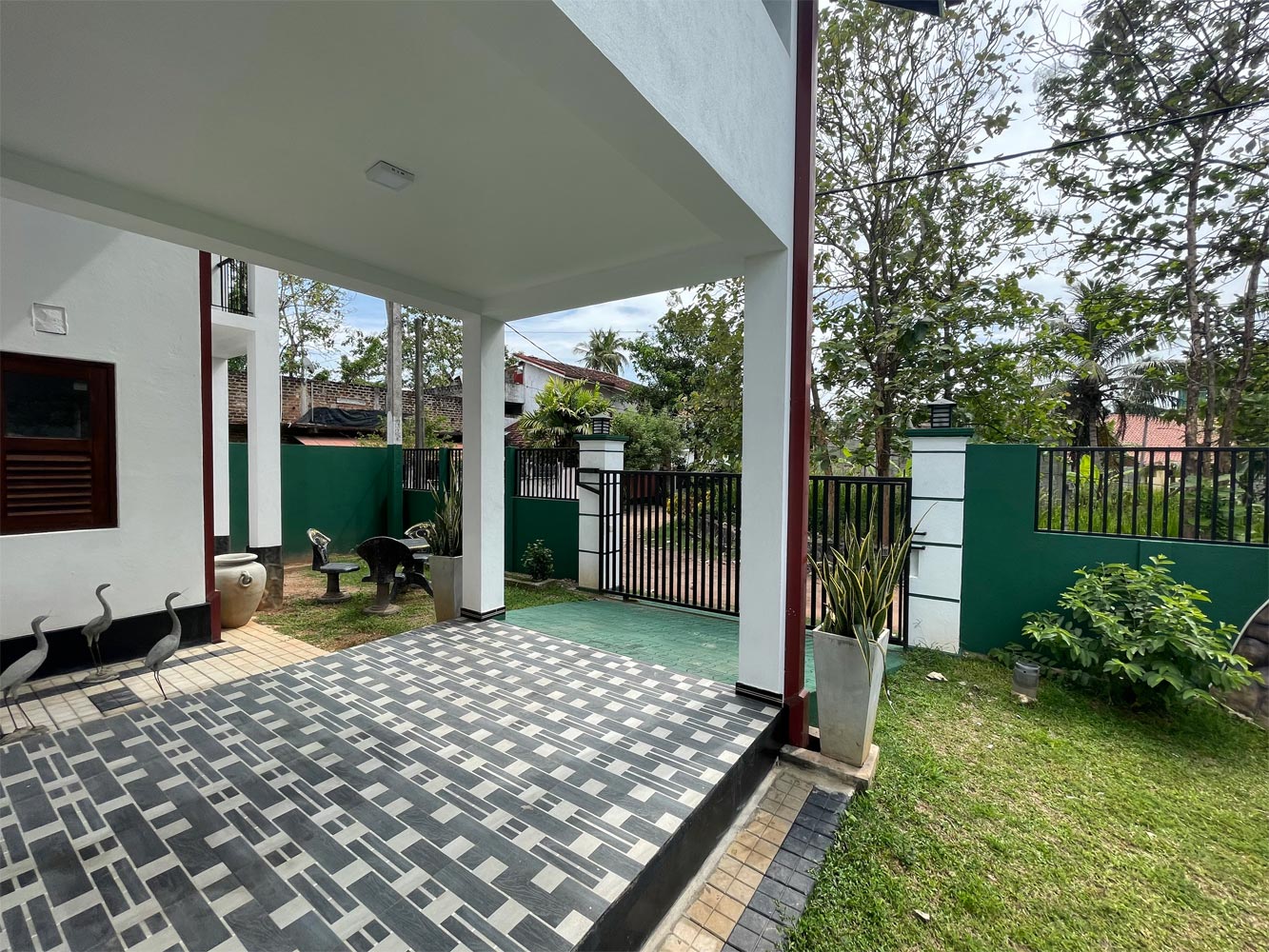
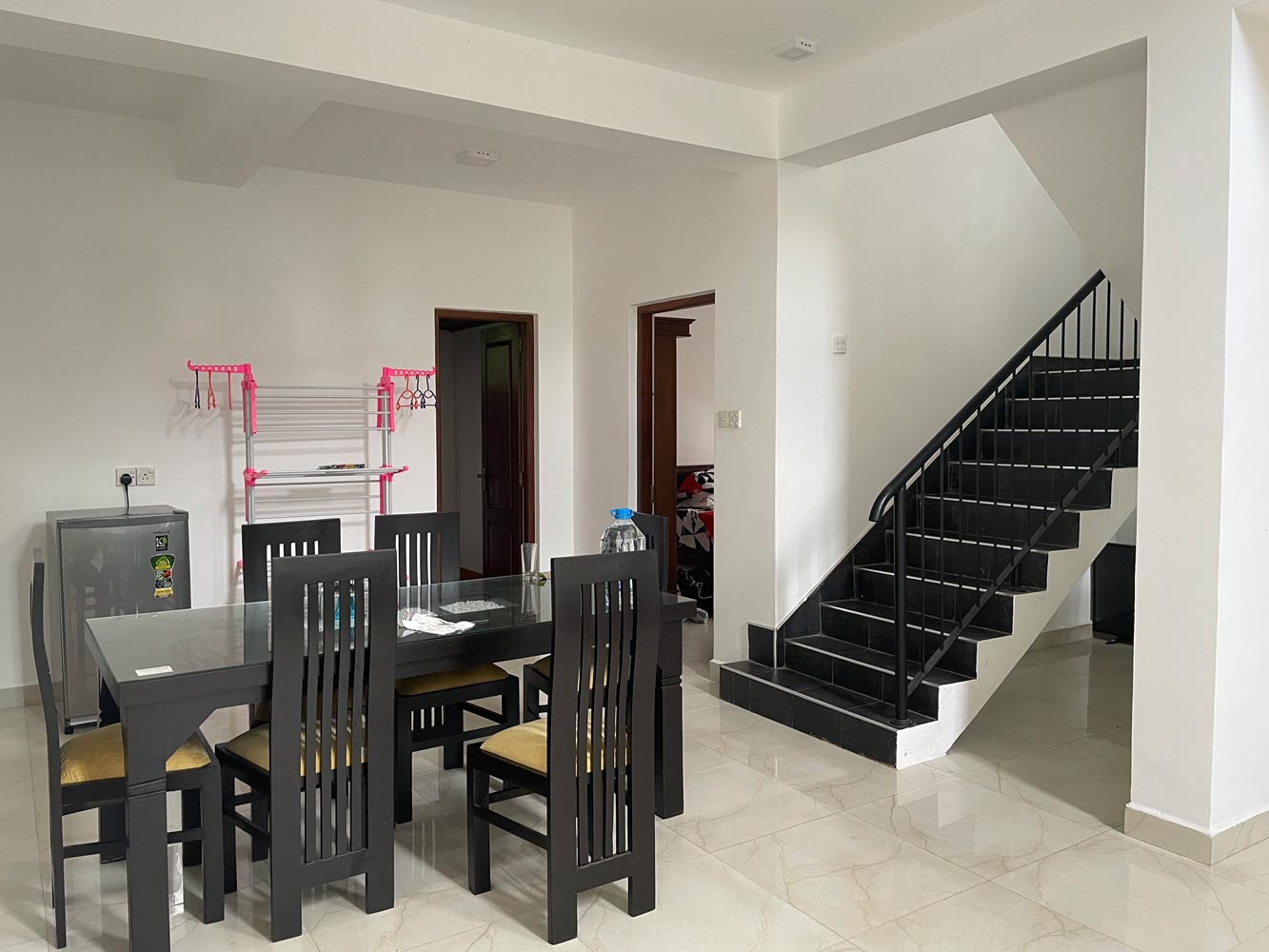
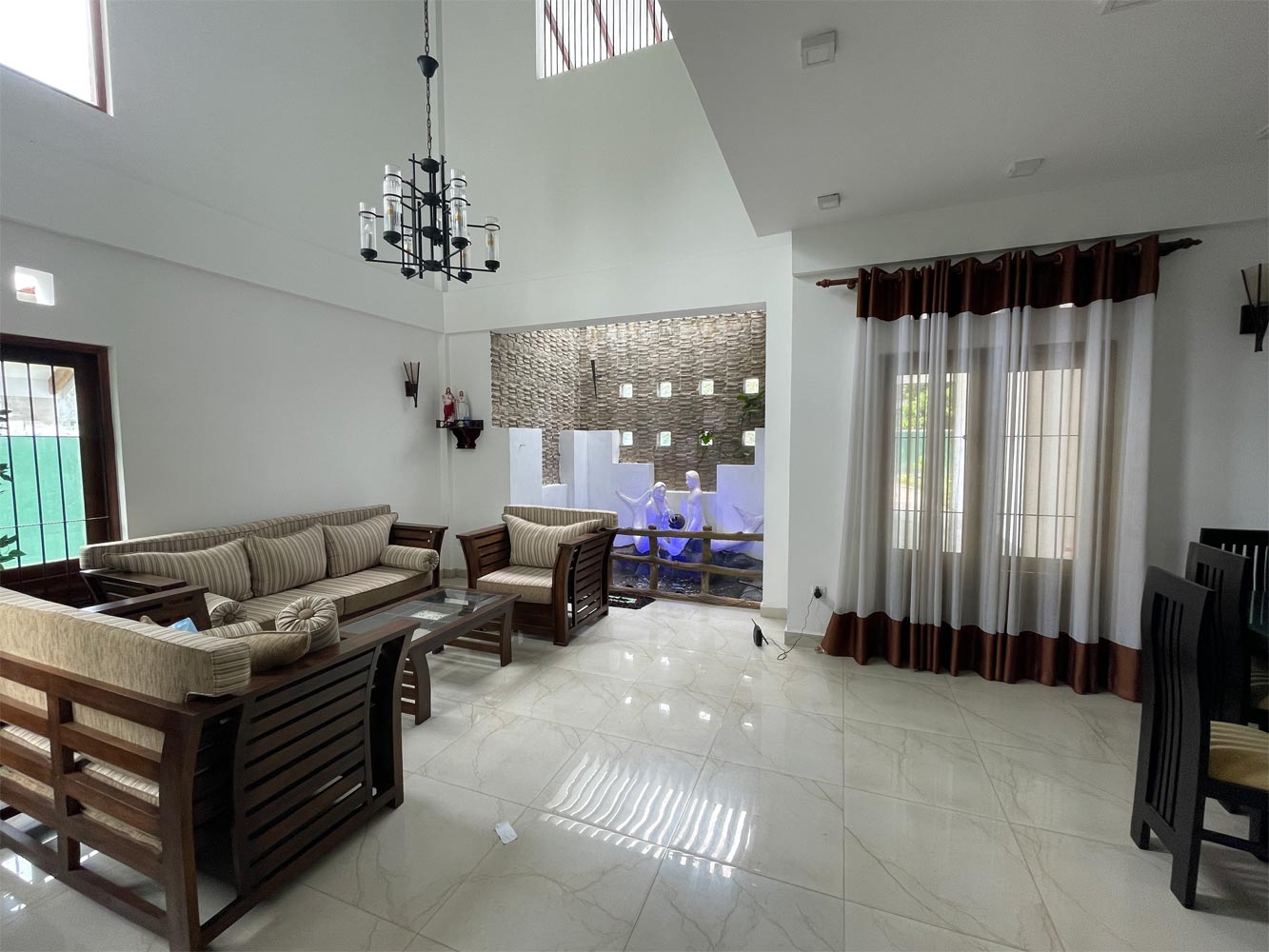
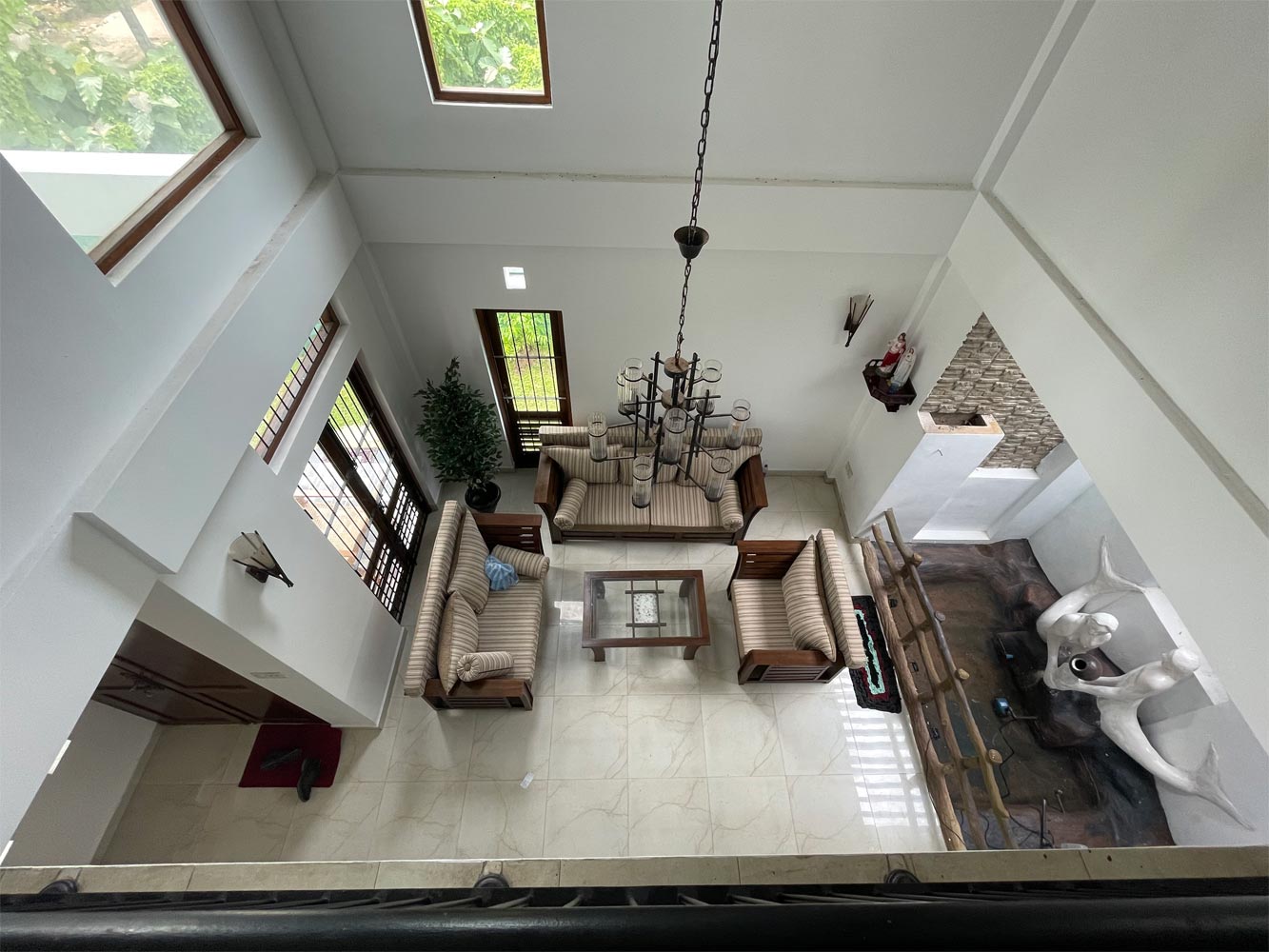
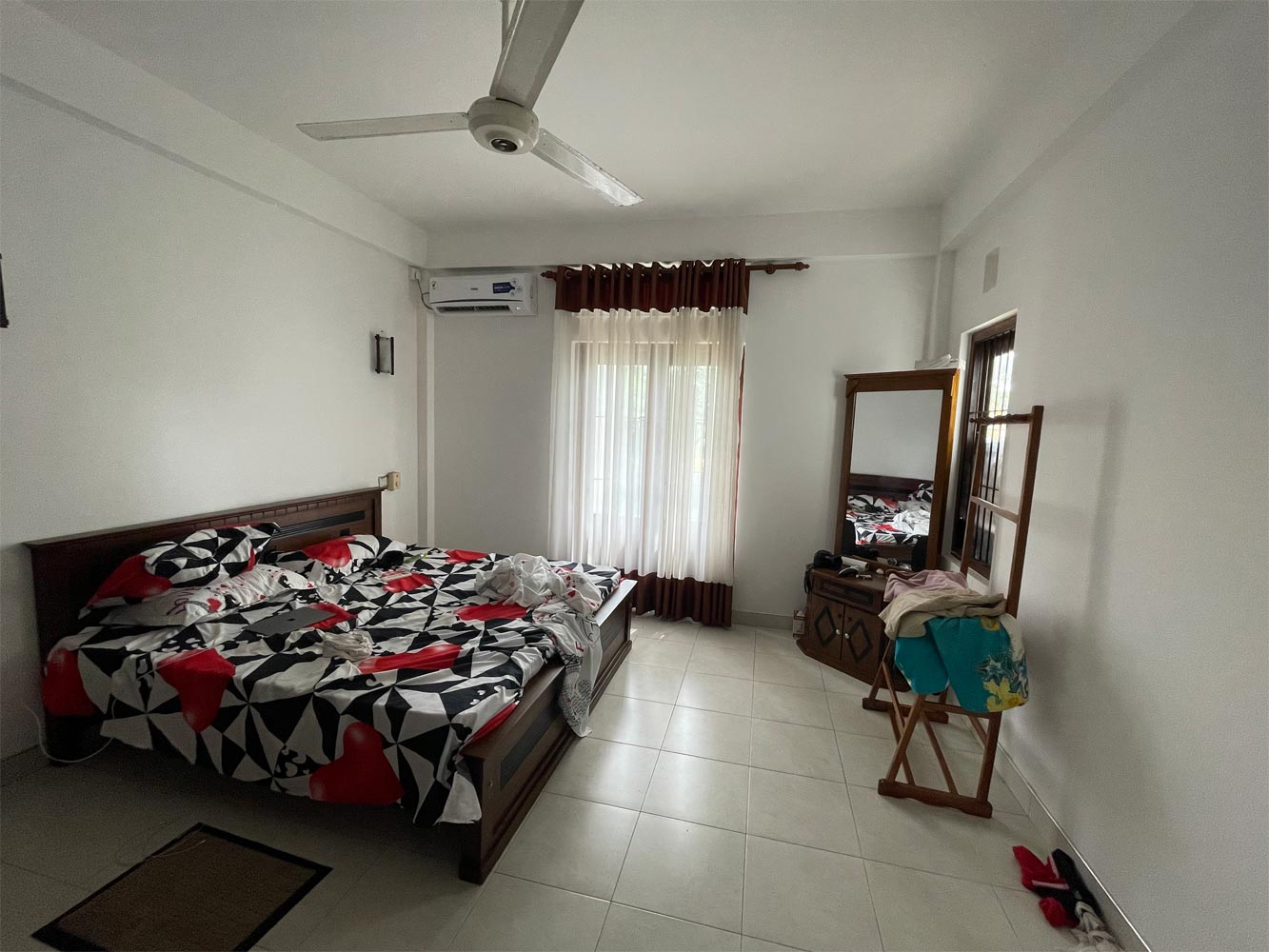
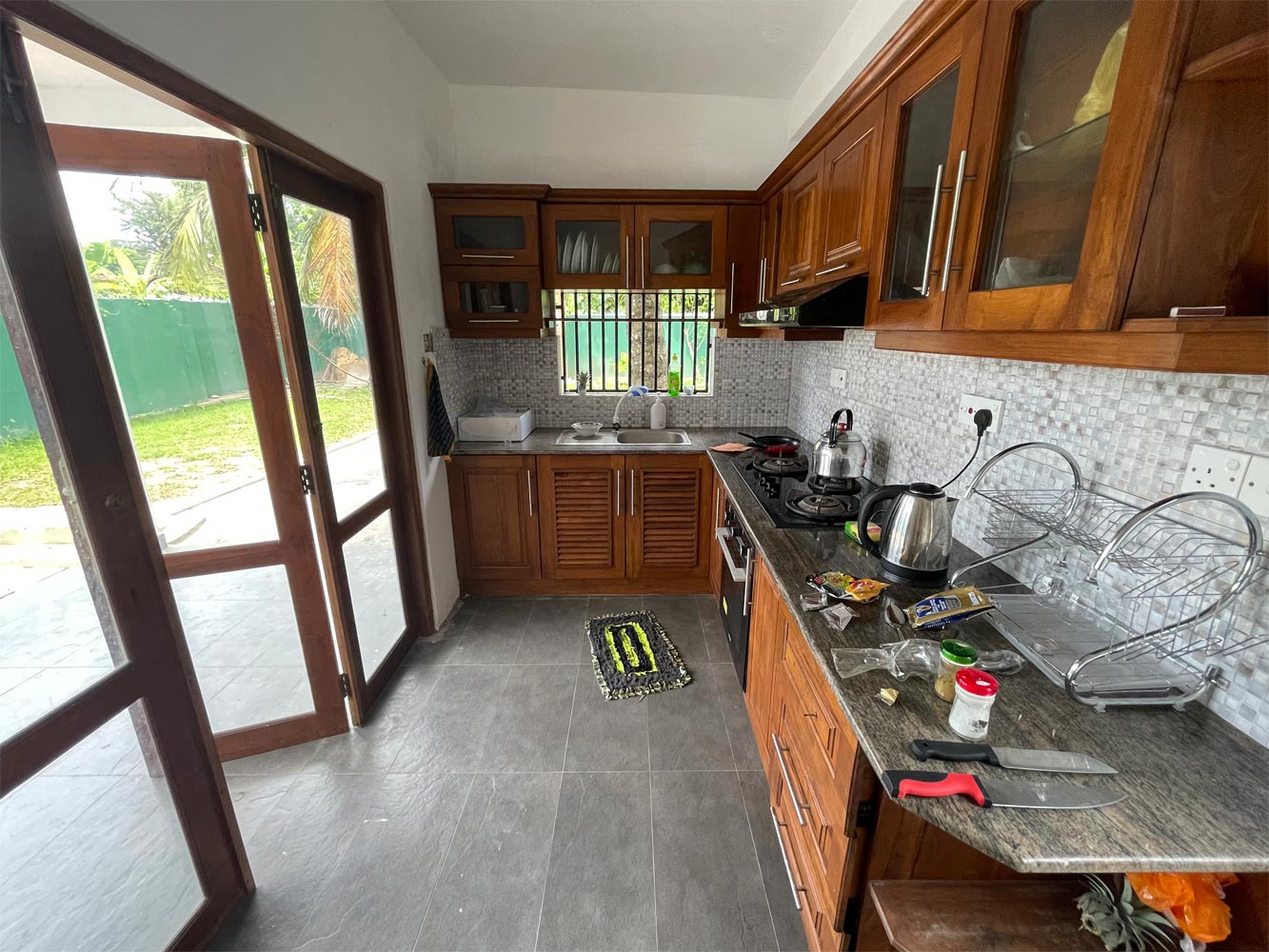
Each villa comes with a ticket to the zoo. Tropical animals will be constantly running around the garden and house. Lizards are the most common among them.
Iguanas and monitor lizards crawl through the garden and freeze in place if disturbed. They don’t attack unless cornered. On the contrary, as soon as you approach them, they run away as fast as they can.
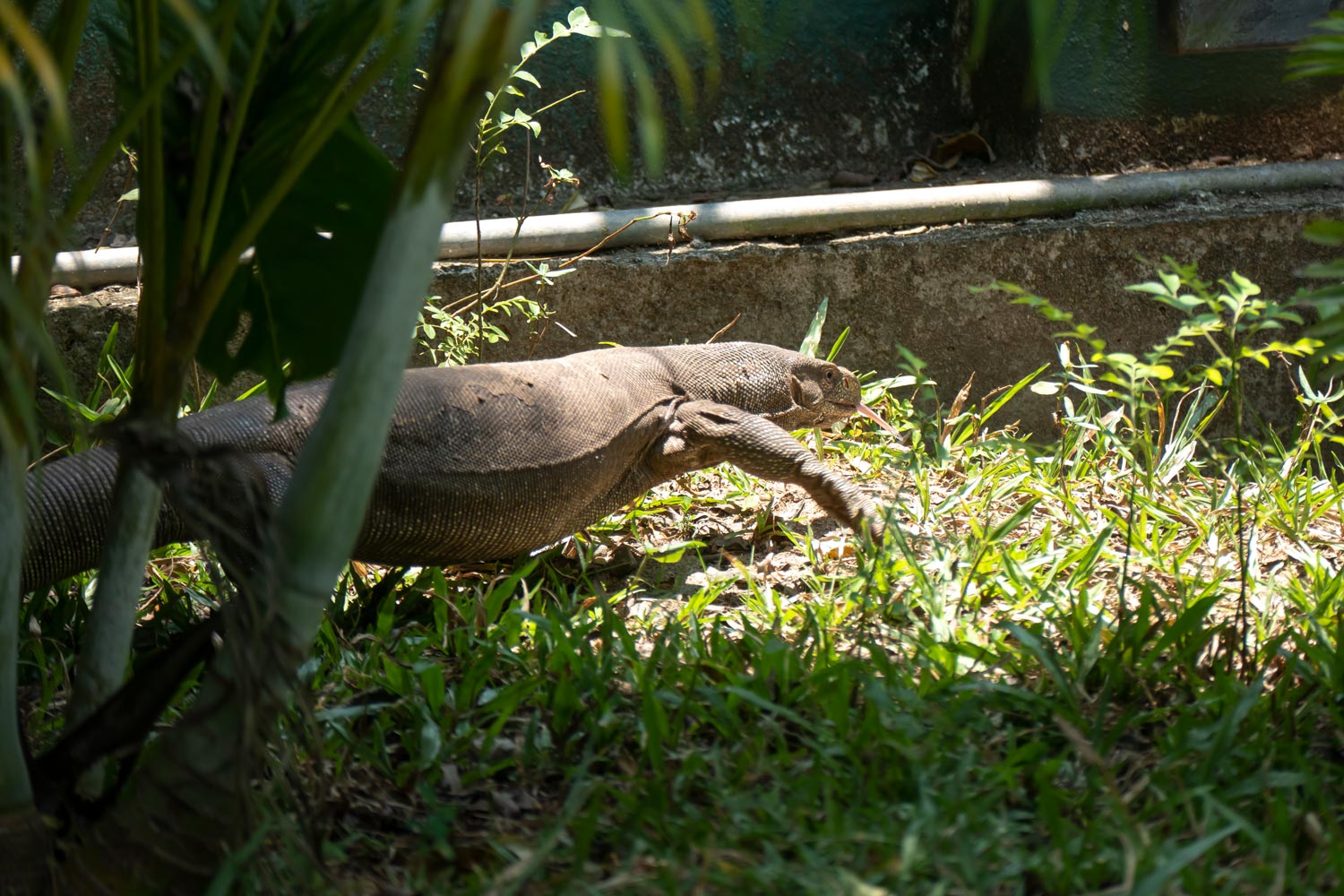
In addition to the large lizards, there are also small ones. They constantly run along the fences and sometimes climb into the house.
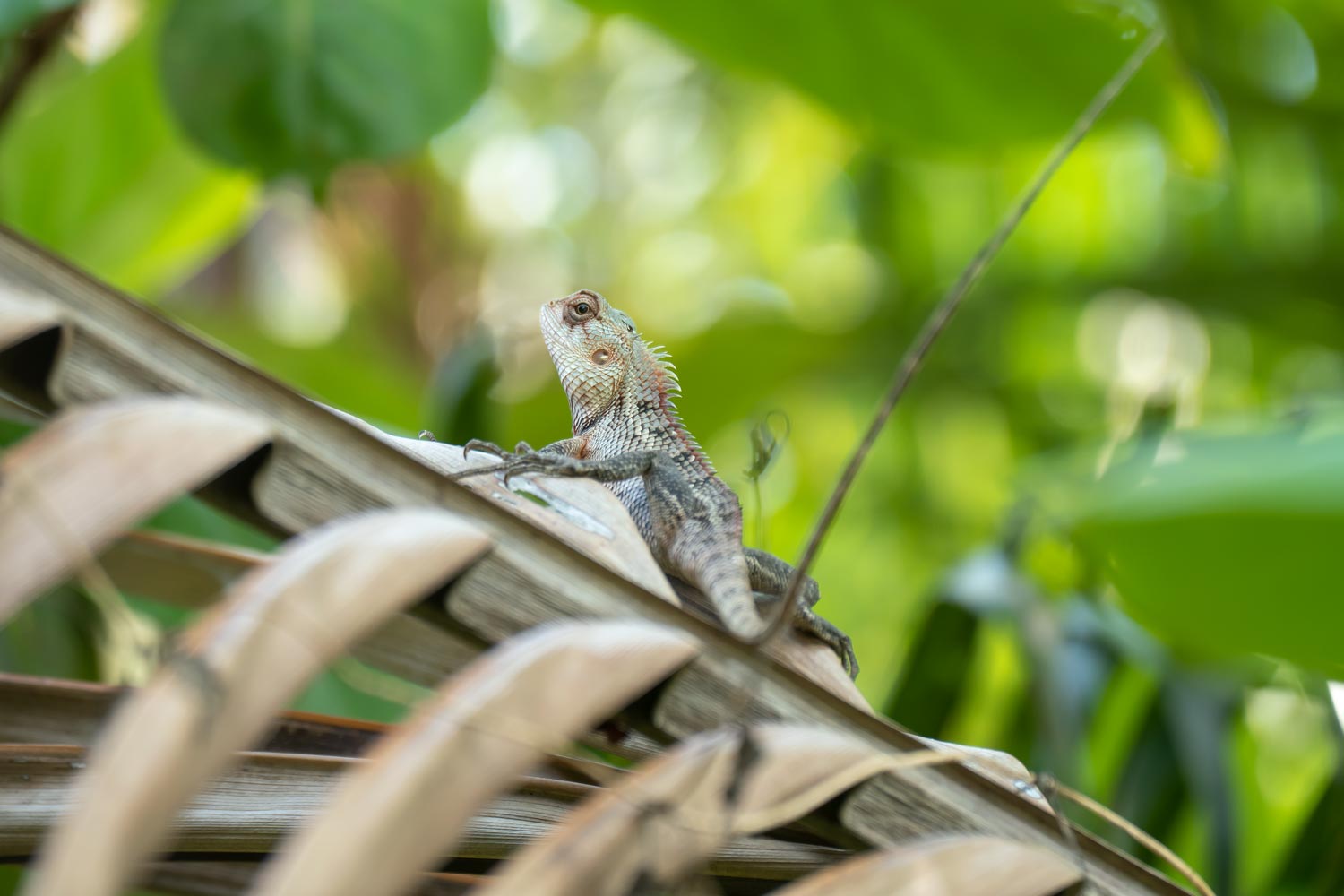
Squirrels constantly jump along the branches. At night, they like to jump onto the roof and make noise.
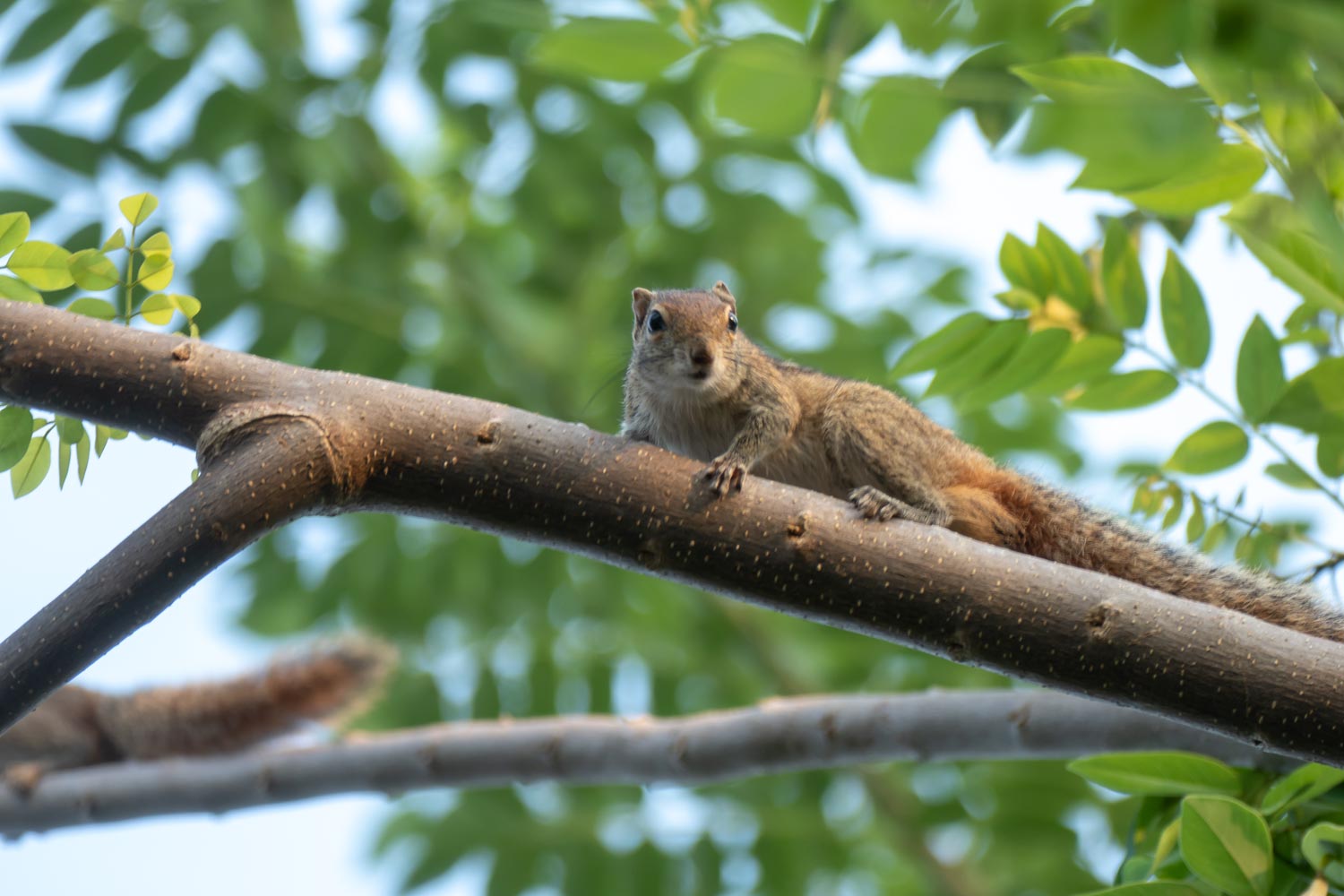
In general, you can forget about silence in Sri Lanka. The noise of squirrels, the rustling of monitor lizards, and barking dogs will be constantly heard. But most of all, the constant chirping of crickets and cicadas will annoy you. In the bushes, there are huge crickets like this one.
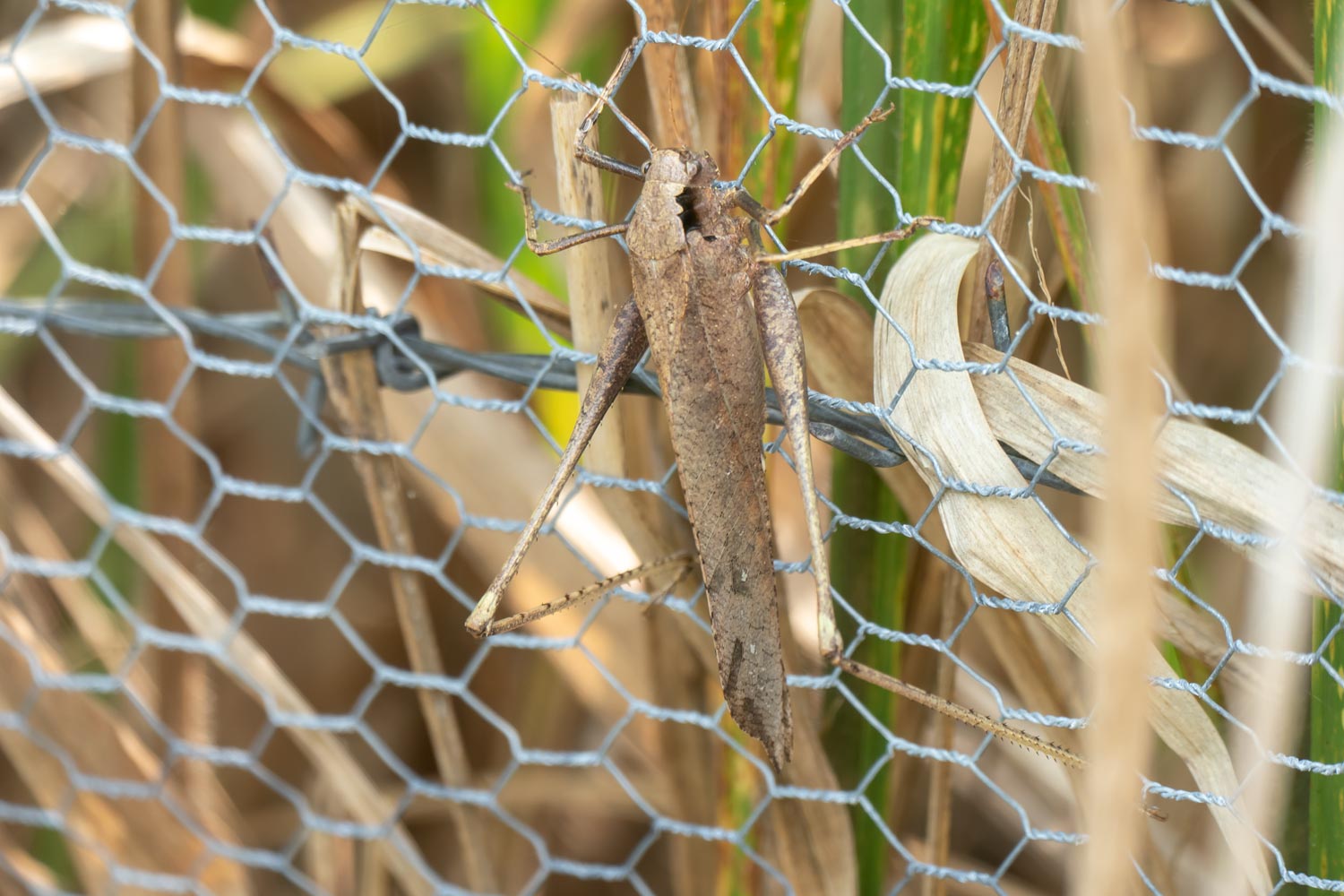
Sri Lankan crickets chirp very differently from those in the temperate zone. It sounds more like bird singing. At first, I thought it was a bird until I found a cricket in the bushes.
Crickets are not poisonous. However, spiders can be. Sri Lanka has plenty of venomous spiders. The only spider that is found in homes in Sri Lanka is the Huntsman spider. It can be easily found on curtains or in corners.
This spider is venomous but not deadly. Its bite is similar to a wasp or hornet sting. The bite area may turn red and be painful for several days. There may also be an increase in temperature, nausea, and headaches.
Fortunately, it is very difficult to provoke a spider. I tried to attack it, but it just ran away. To make a hunting spider bite, you need to bother it for half an hour or corner it.
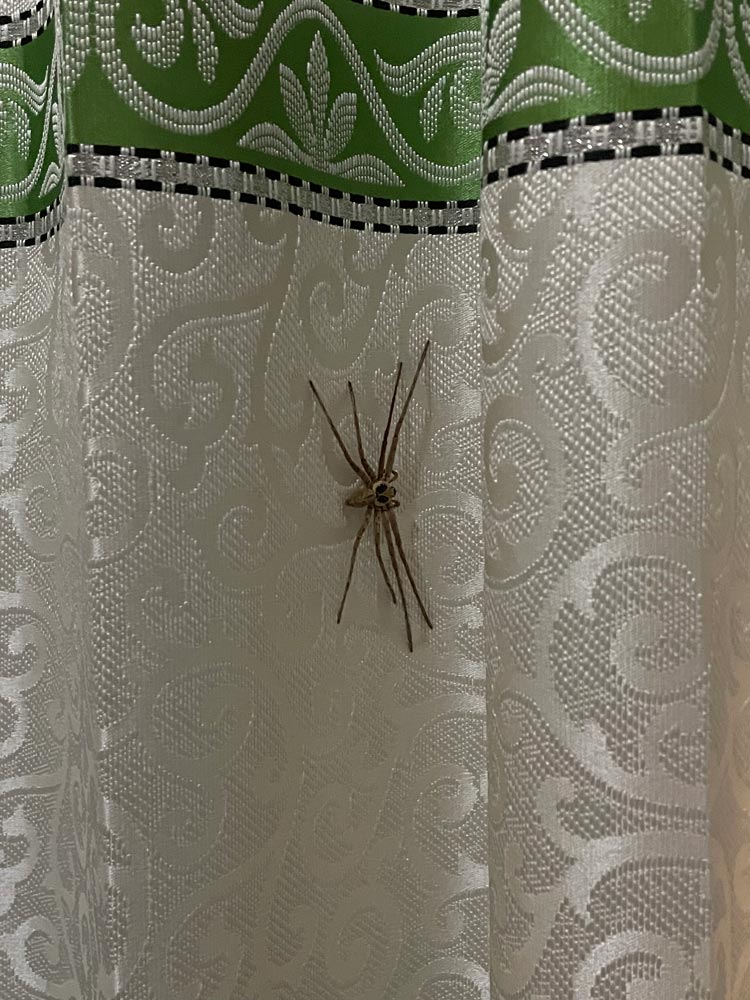
There are venomous snakes in Sri Lanka. The villa owner asks to close the doors at night so that a snake does not crawl in. Although I haven’t seen any snakes during my month and a half on the island, a snakebite can be deadly.
Well, mongooses eat all this nasty stuff. They constantly run around the villa in search of snakes, lizards, and crickets.
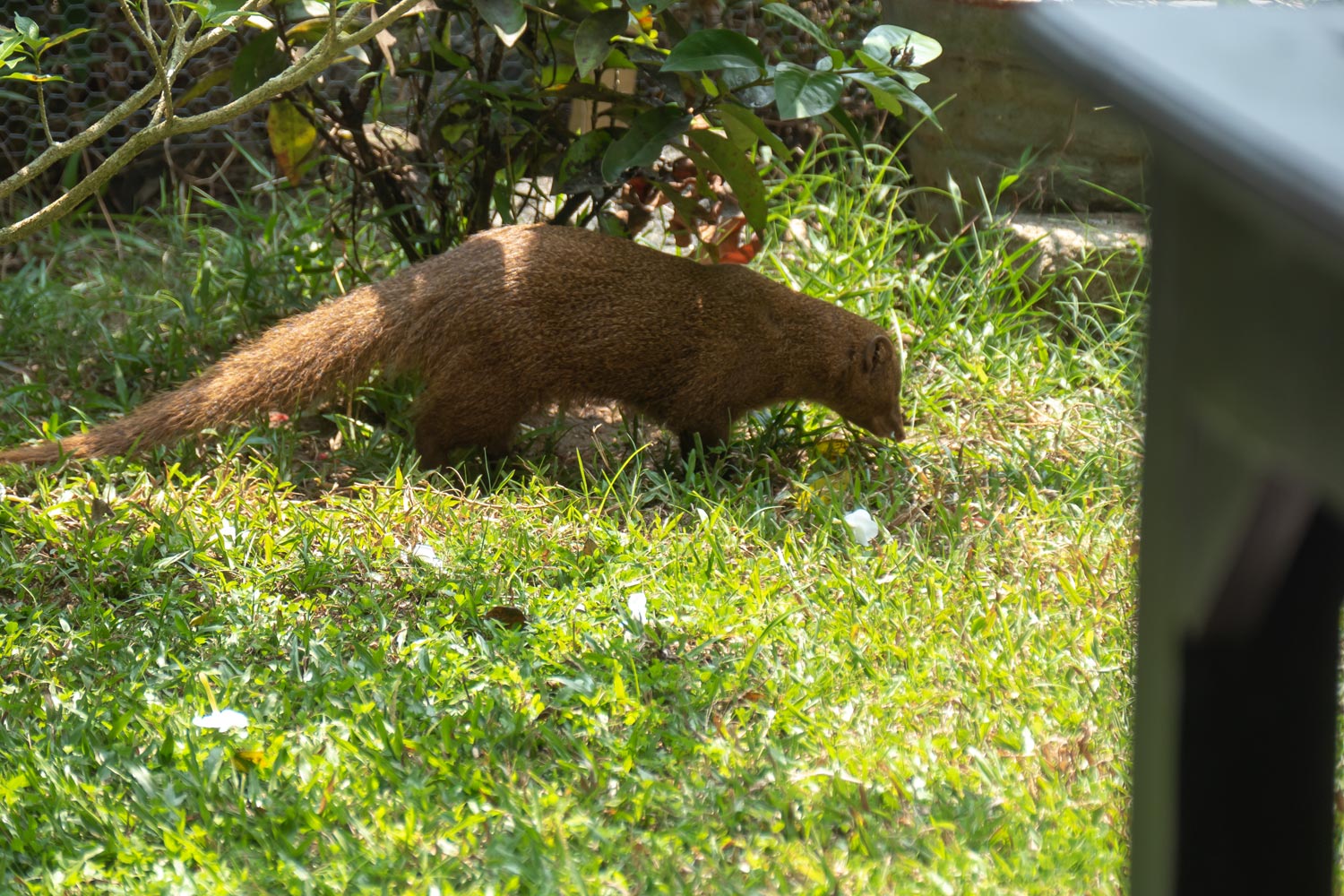
Beaches.
Hikkaduwa beaches are the best in Sri Lanka.
First of all, it’s almost always a scene from a movie.
Secondly, the ocean here is the calmest. There is a coral reef growing underwater in the center of Hikkaduwa Beach, which breaks the waves. You can swim calmly even in bad weather.
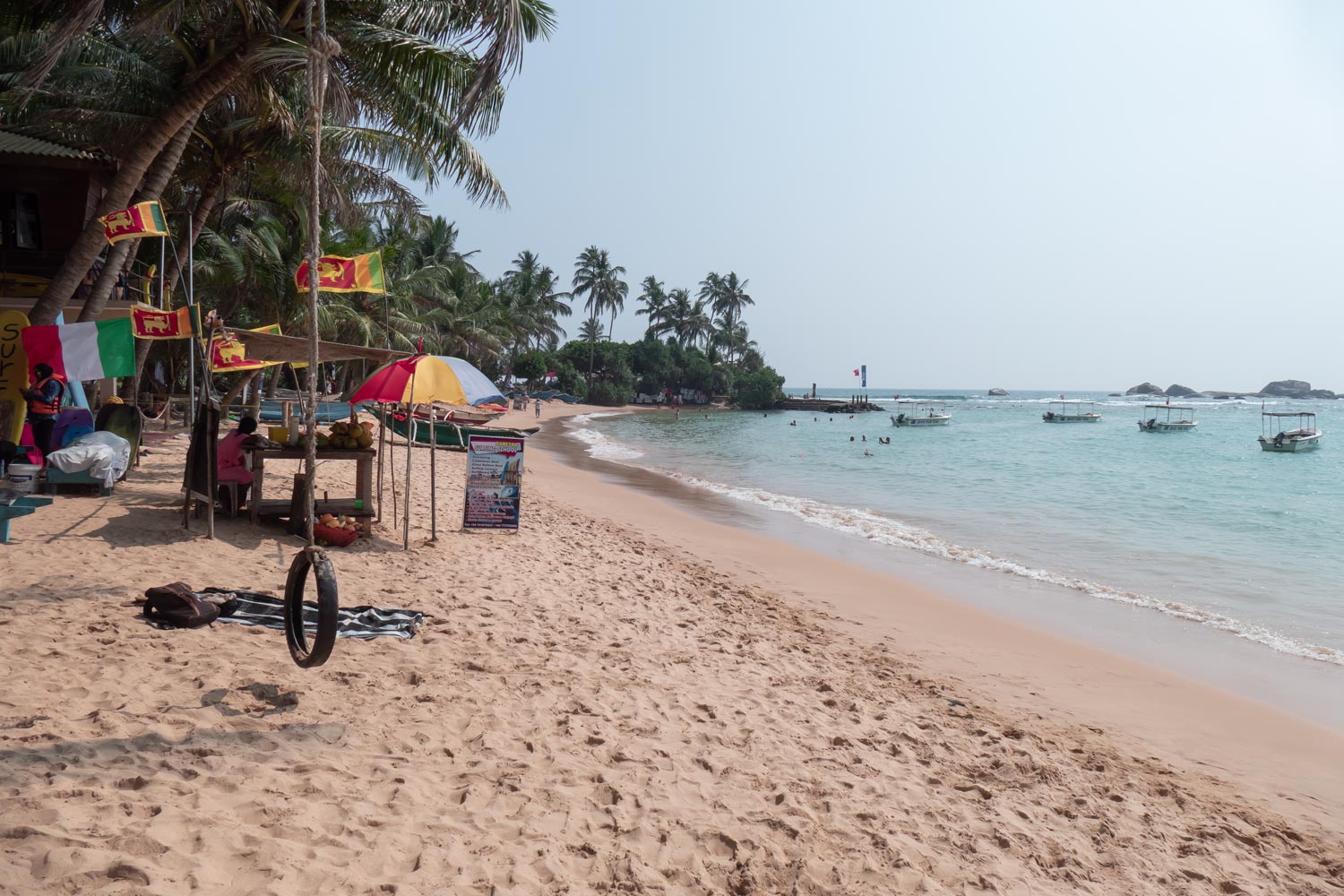
Coconuts are sold on the beaches; there are umbrellas and sun loungers.
Technically, drugs are prohibited in Sri Lanka. However, in Hikkaduwa, they offer to buy hashish and marijuana at every step. Cocaine is rare, but psychedelic mushrooms are often offered.

The beach stretches for many kilometers along the entire Hikkaduwa. In general, the entire coast of Sri Lanka is one continuous beach. Only on wild beaches, there are big waves, so it’s harder to swim in them.
But big waves are good for surfing. And all beaches in Sri Lanka are packed with surfing schools.
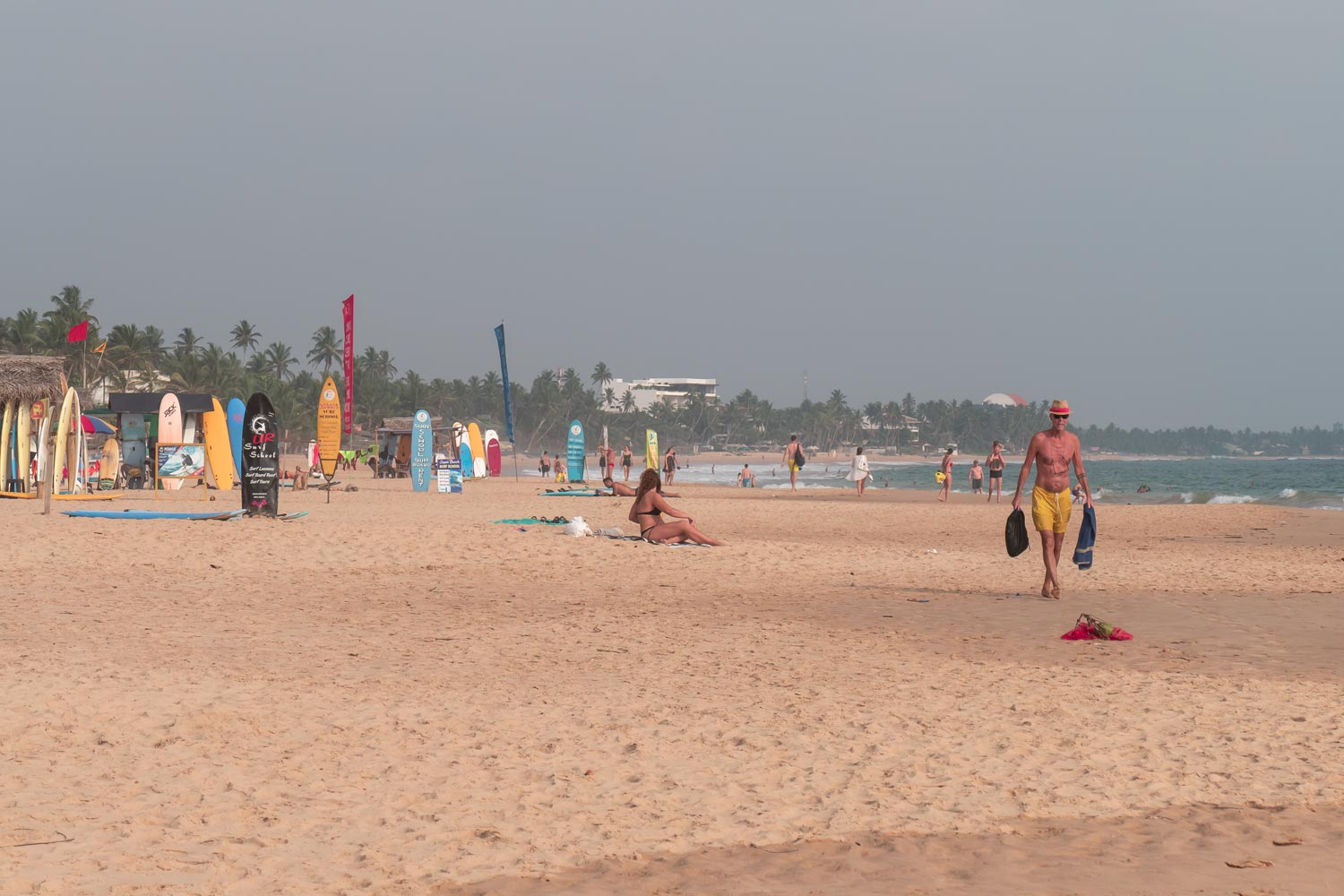
The highlight of Hikkaduwa is the Turtle Beach, where locals feed giant green turtles that you can swim with.
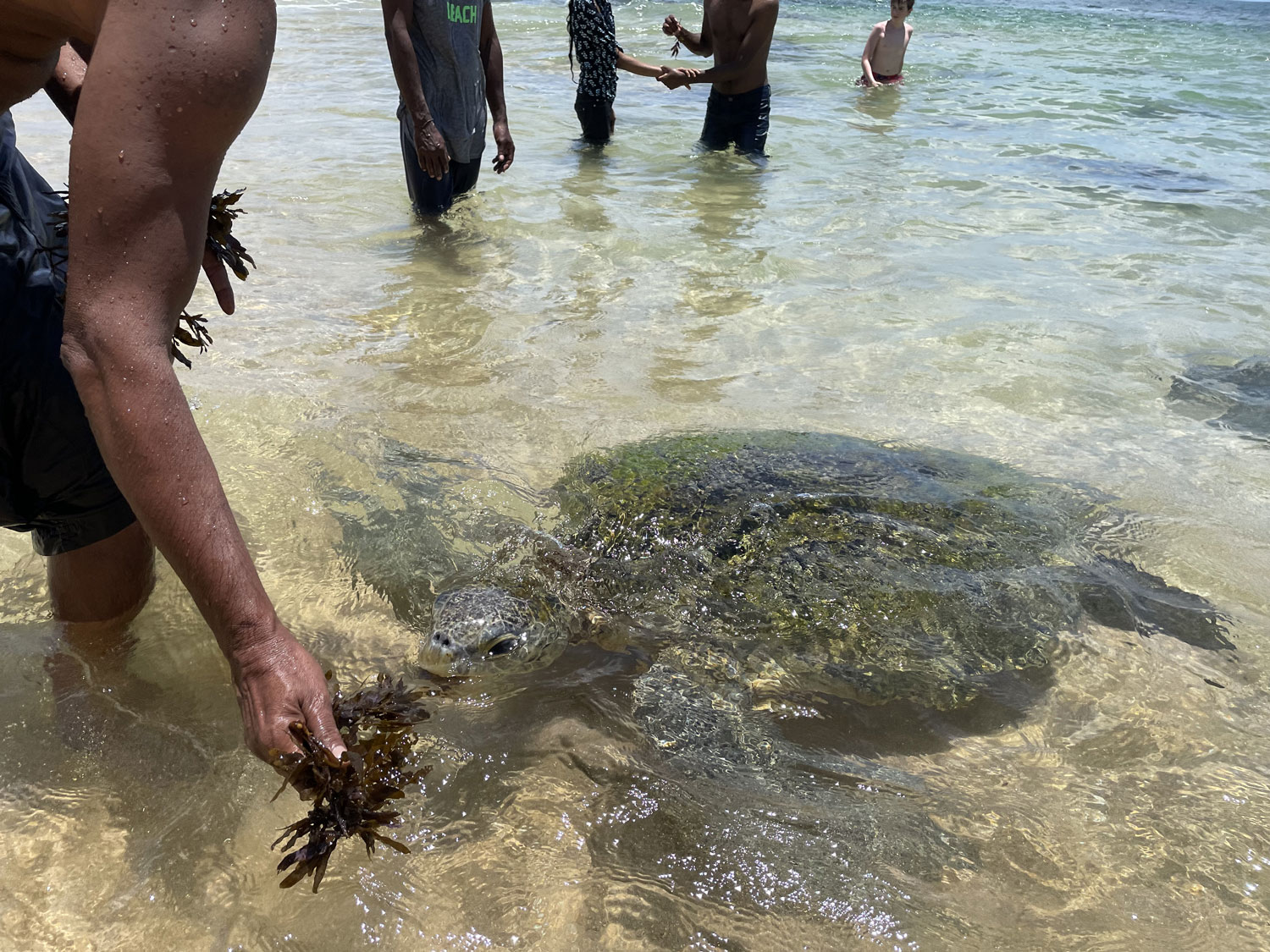
There’s no such thing on Negombo beaches. Here, the waves are always big, and there are no turtles.
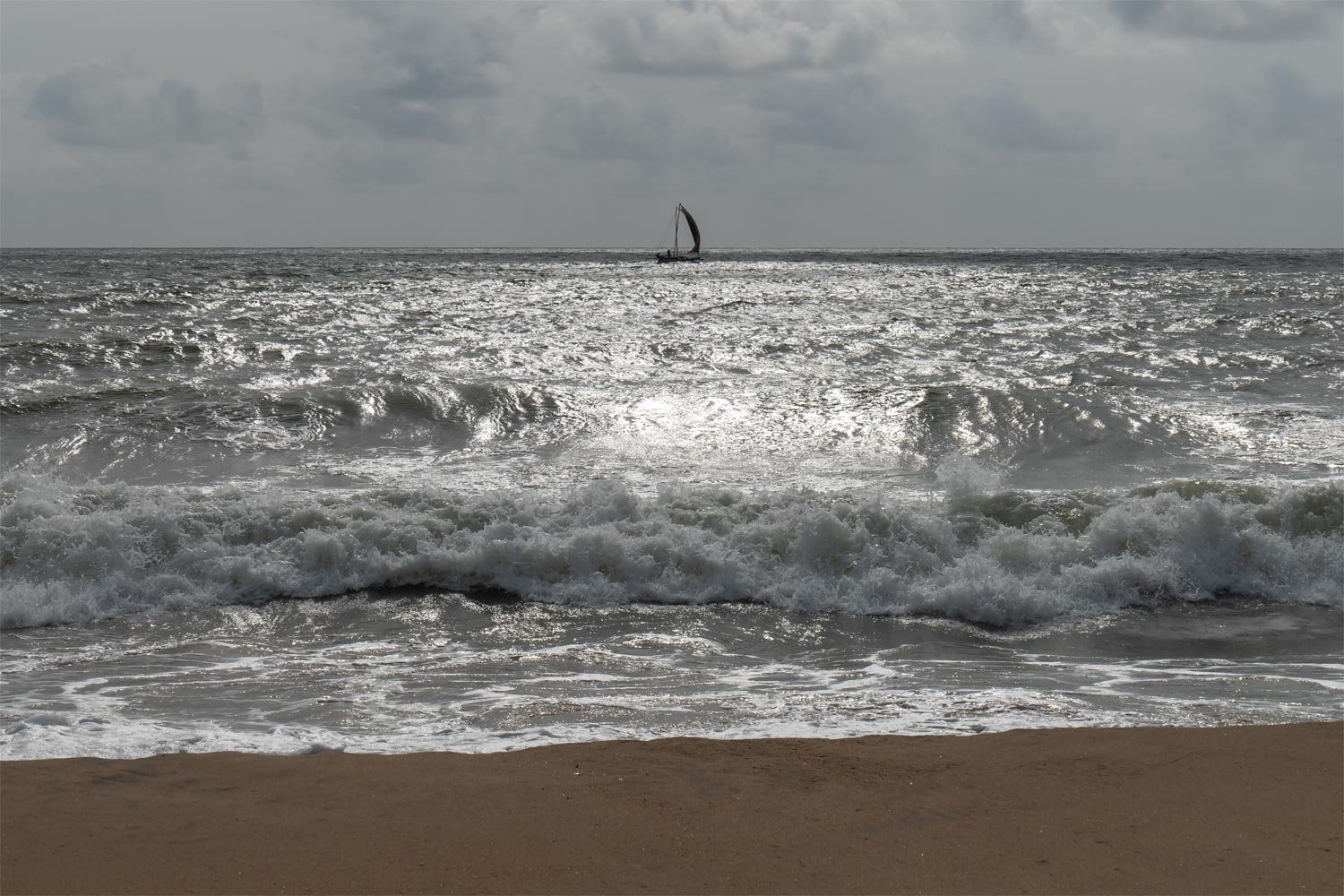
The coastline of Negombo is filled with cafes and restaurants, and behind them are not only huge hotels but also high-rise buildings. Apparently, Negombo will soon turn into a noisy village like Phuket.
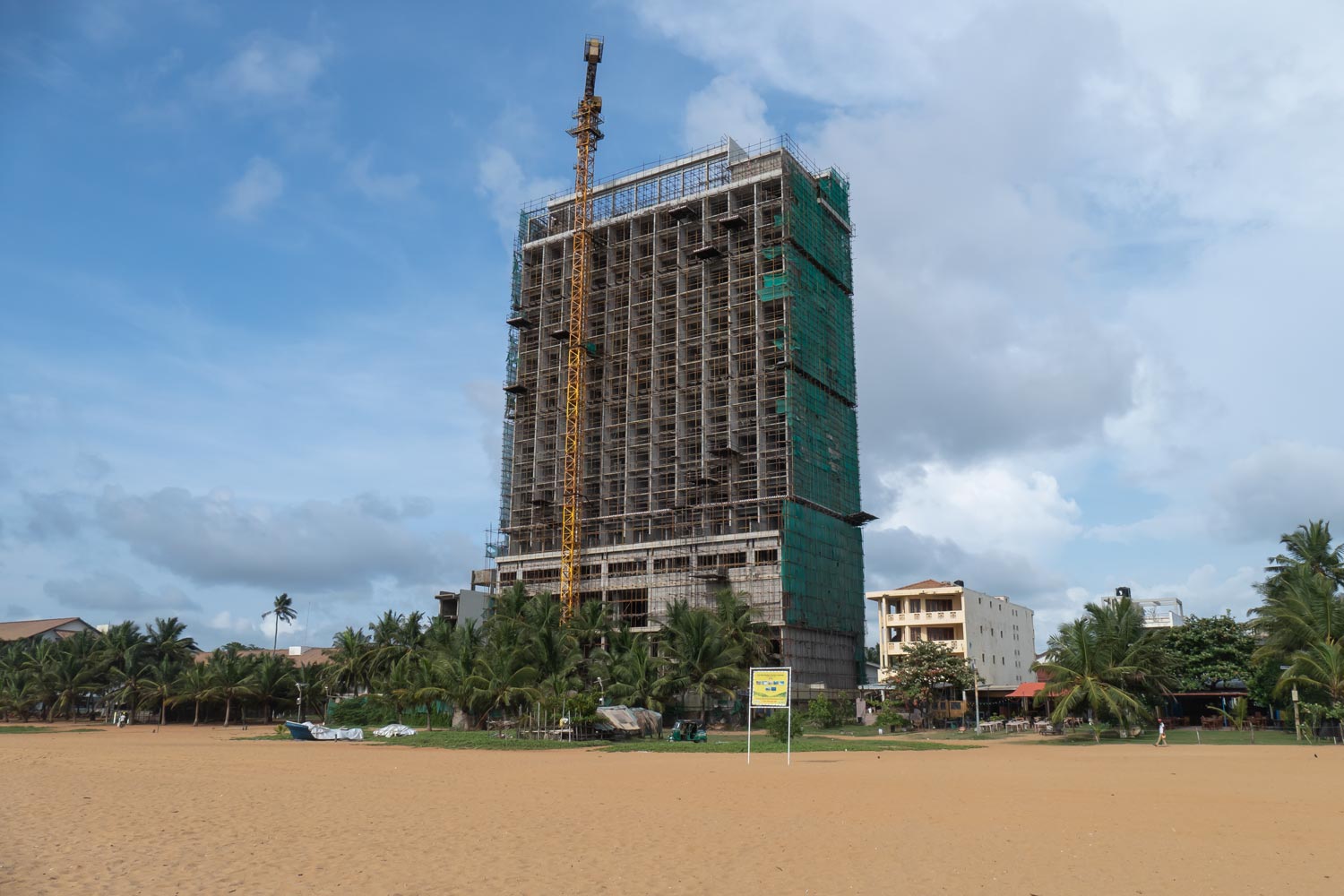
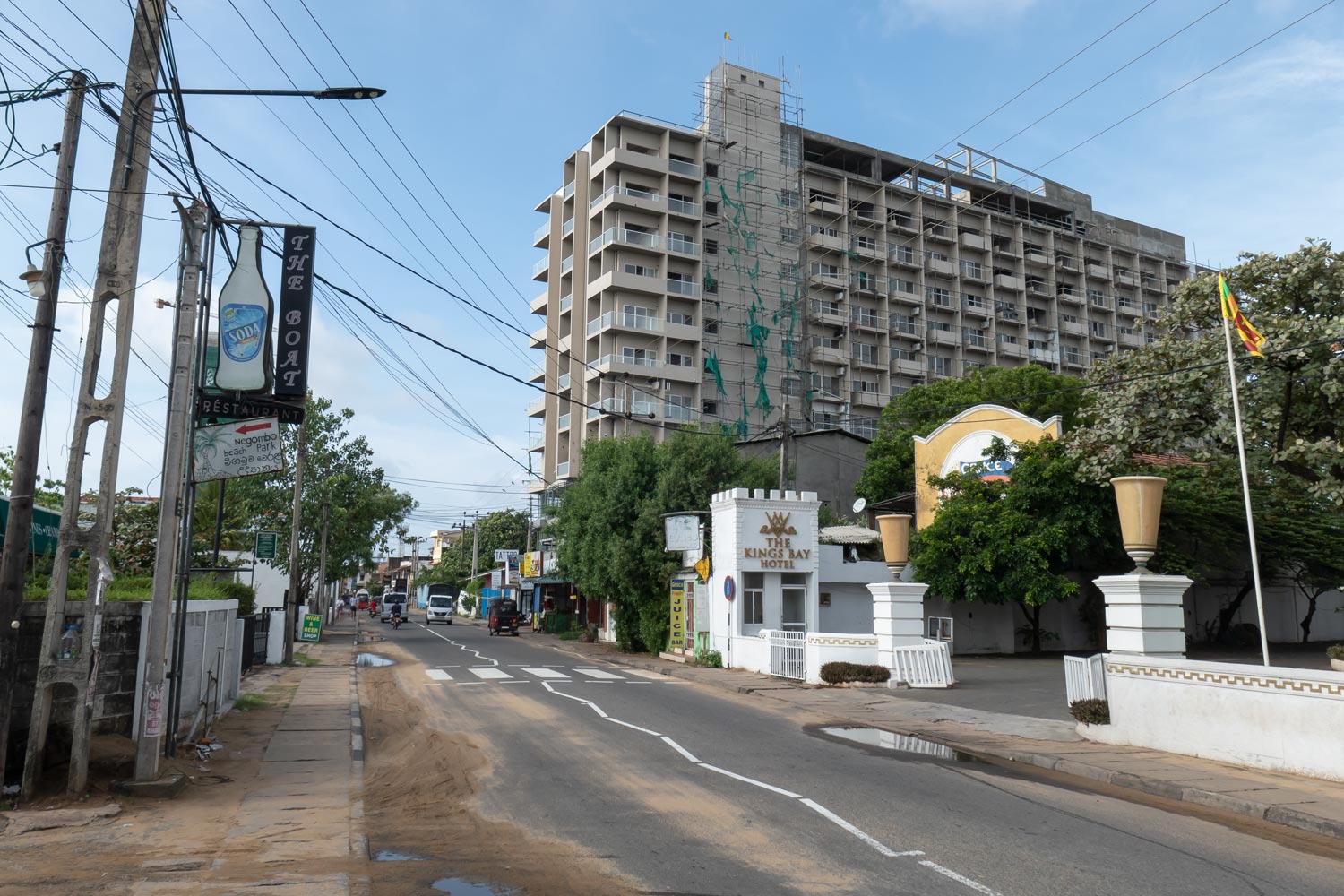
There is only one five-story hotel in Hikkaduwa, and most cafes are located right on the ocean’s edge. You can even go down the stairs and get directly into the water there.
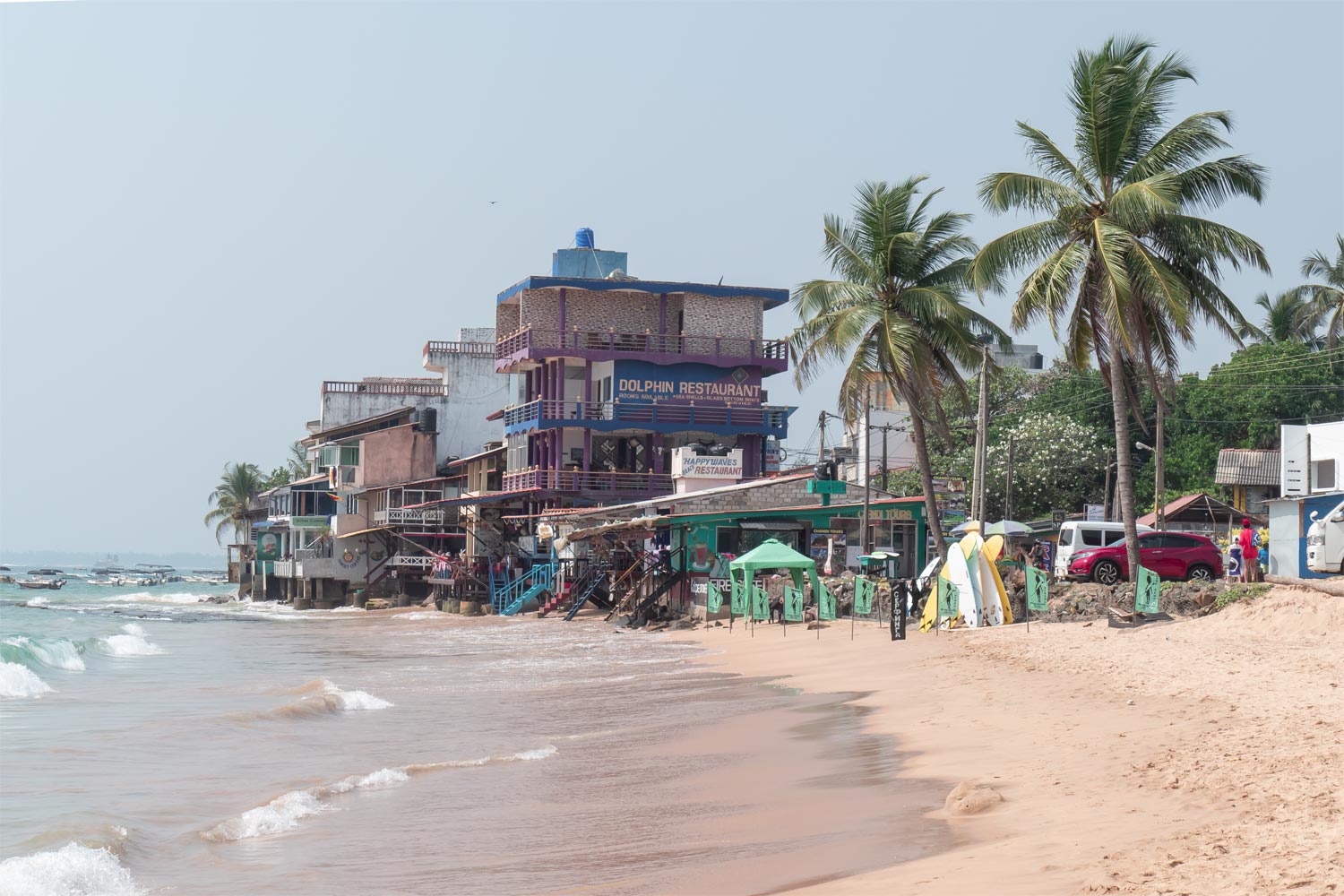
Sri Lankans
Forbid you Buddha from calling Sri Lankans Hindus.
These are two completely different peoples who don’t even look alike. Hindus have more round faces, and they behave like weirdos. Sri Lankans have elongated faces, dry and wrinkled skin, an intelligent gaze, and calm behavior.
Calling a Sri Lankan a Hindu is an insult! However, the term “Sri Lankan” is a collective term. It’s like calling someone a Russian or an American. There are no Sri Lankans; there are ethnicities in Sri Lanka such as Sinhalese, Tamils, and others.
The majority of Sri Lankans are Buddhists. Buddhism is practiced by 75% of the population in Sri Lanka. But this is also a rough estimate. It’s just that 75% of the country’s population are Sinhalese, and they all are Buddhists, while the other ethnicities equally practice Hinduism, Islam, and Christianity.
Buddhism in Sri Lanka is also not simple. It’s the oldest school of Buddhism, called Theravada. It’s based on the most interesting collection of religious texts written in the Pali language. This language is considered sacred, like Latin for Buddhism. Theravada is the only branch of Buddhism whose canon is written in this language.
Religious ceremonies in Sri Lanka are still conducted in the Pali language, although it’s a dead language that no one speaks in everyday life.
That’s correct. In Sri Lanka, people speak Sinhala and Tamil, both of which are official languages.
I understand how it may look to the reader. A small island with two similar official languages, both of which are equal. Weird, right? Why not merge the languages and speak something in between?
That’s true. This is the view of imperialists from the other end of the planet on a distant and unique culture. Tamil and Sinhala are two completely different languages! They have as much in common as Chinese and Japanese or Russian and Czech. Sinhala and Tamil even have different alphabets. Although the letters are similar in shape, the similarity between them is the same as between Latin and Cyrillic.

The Sinhalese language belongs to the vast Indo-European family. It is our native language family, which includes Russian, German, and many others. Tamil language, on the other hand, is a completely different matter. It belongs to the Dravidian language family. I myself had never heard of it until I learned about the Tamil language.
Interestingly, 70 million people speak Tamil language. It is not only Sri Lanka but also almost the entire southern India. Additionally, Tamil language is spoken in Singapore and taught in Malaysia.
The Sinhalese language is far behind Tamil language, with only 16 million speakers. Mostly spoken in Sri Lanka and the Maldives. Additionally, the language is relatively younger as a whole.
There is a lot in common between the two languages. Although their grammar is entirely different, there are many similar common words used in daily life. This is not surprising since their speakers have lived next to each other for two thousand years. Additionally, the writing system of both languages is also similar and derived from the Brahmi script.

But why do the letters of these languages have such a strange, rounded shape? This is because writing in Sri Lanka began on palm leaves. Three thousand years ago, our Sri Lankan ancestors wrote the first manuscripts and horoscopes using sharpened sticks on palm leaves.
These leaves have veins, making it very difficult to write rectangular letters like the Latin alphabet. A sharpened stick would constantly stumble upon the veins if making vertical strokes and, conversely, tear the leaf if making horizontal lines. To write on a palm leaf, the letters had to be round!
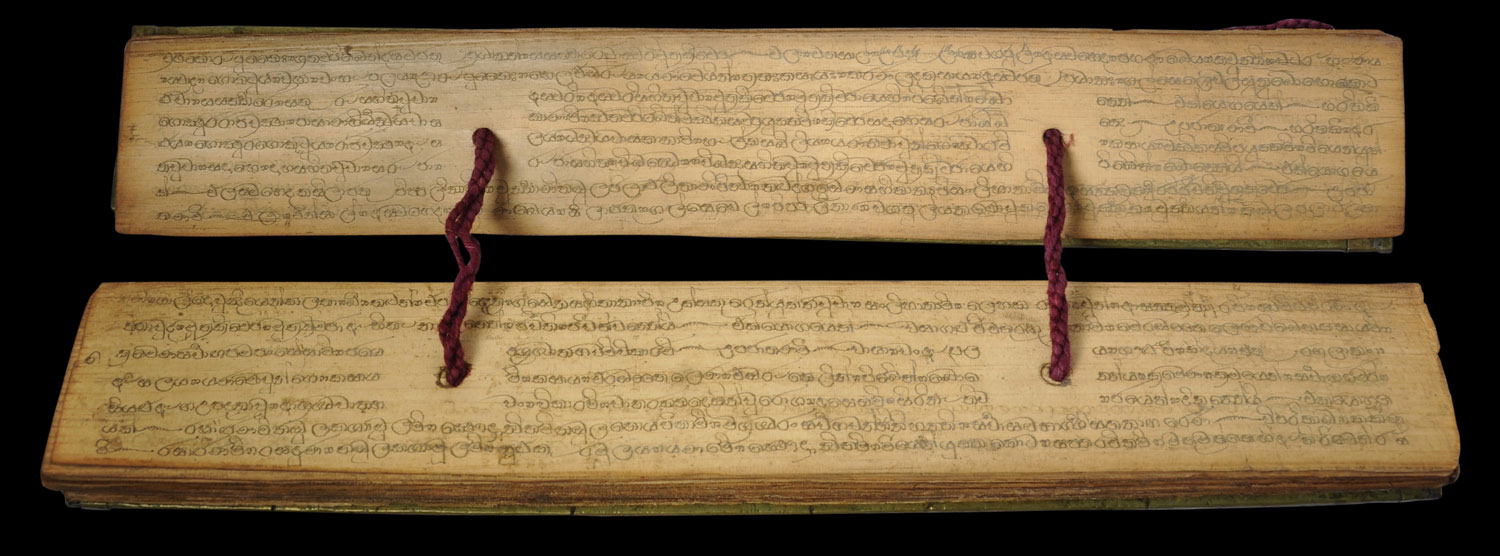
A thousand and one maps
I never thought that studying maps of Sri Lanka could be so interesting. The thing is, the island’s shape resembles a traditional Eastern ornament. It is most often called the “Indian cucumber,” and also referred to as “buta” and “paisley.”
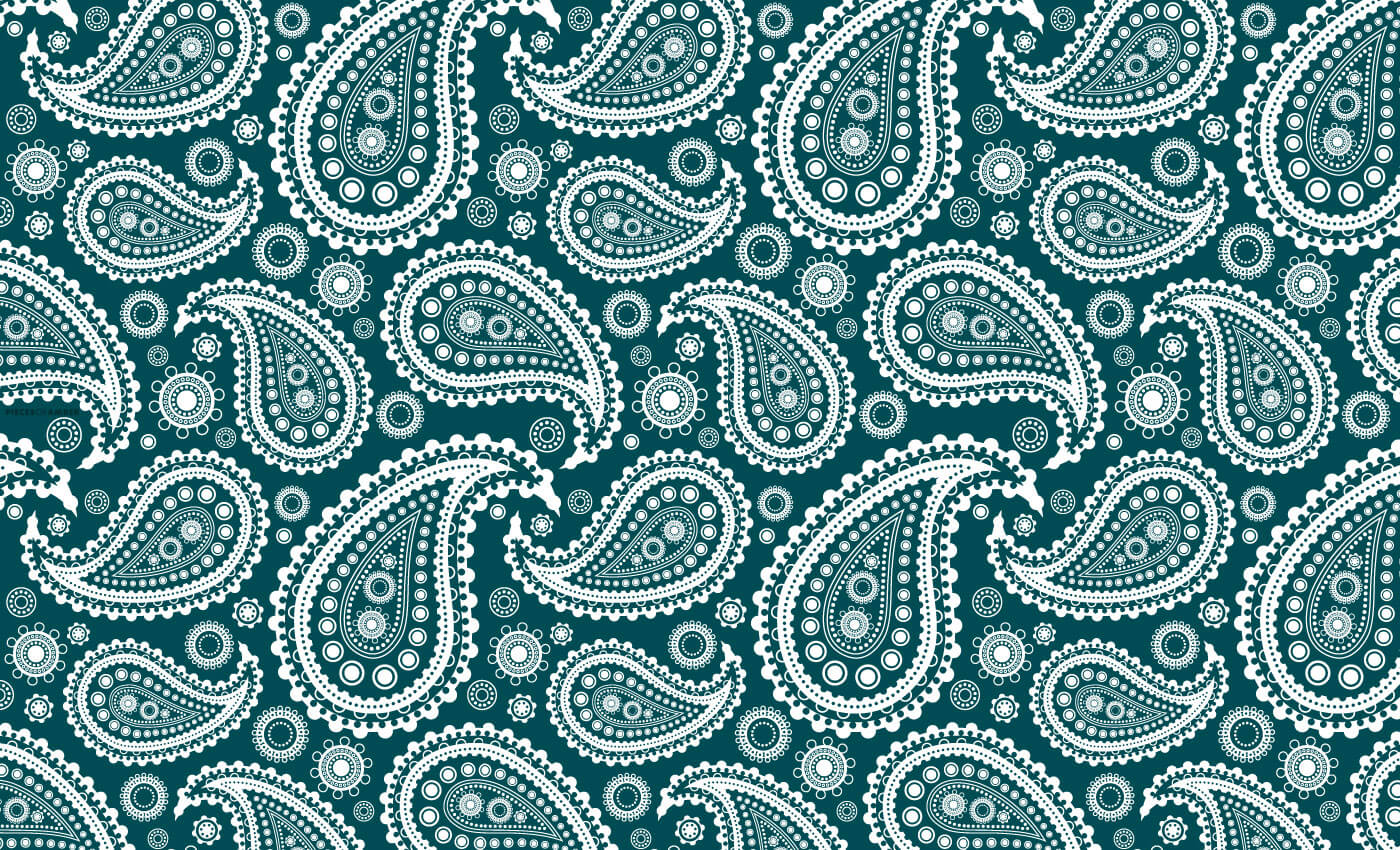
Let’s take a look at some maps of Sri Lanka. Let’s start with the religion map, which shows the distribution of Buddhism:
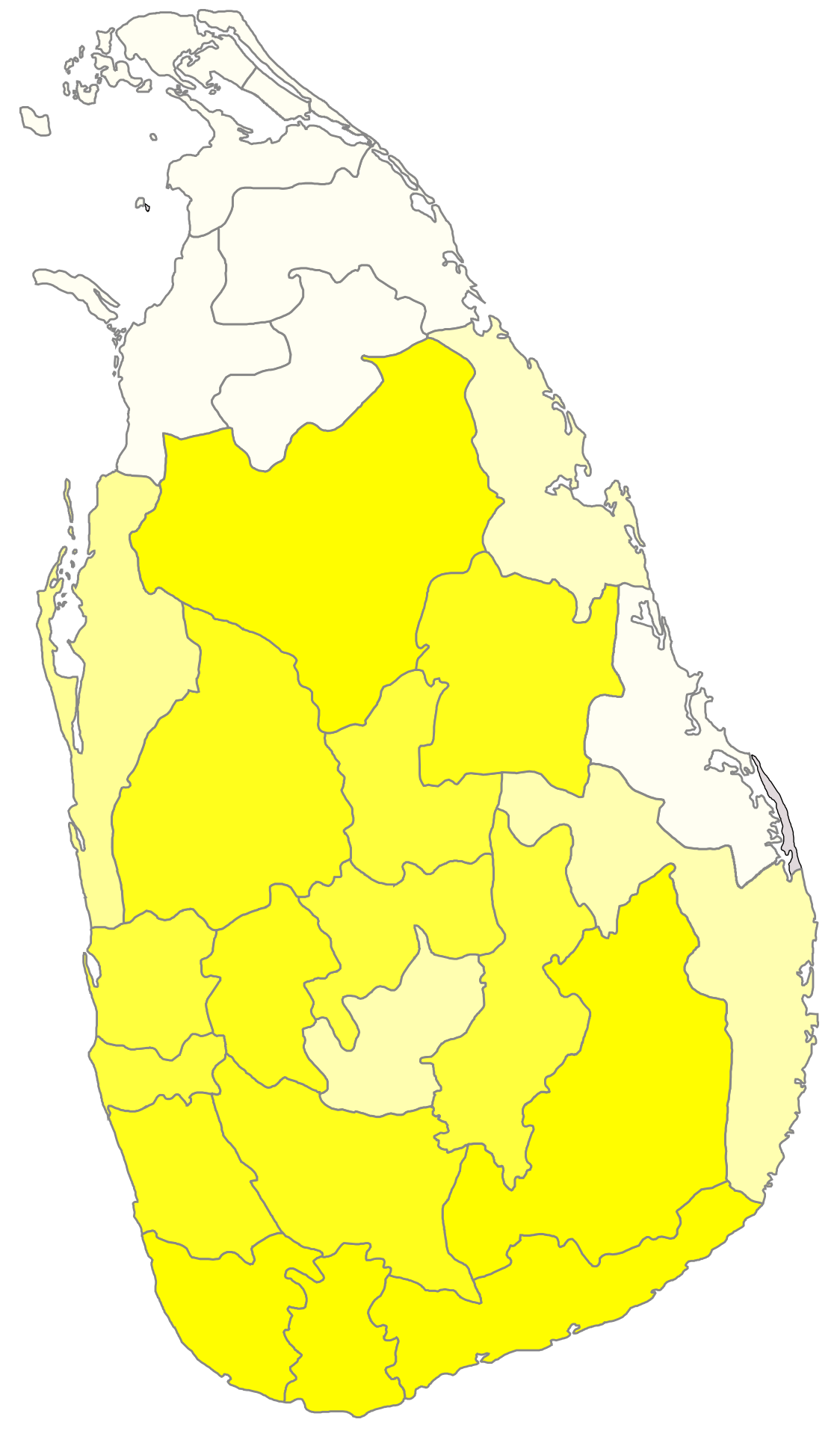
And here is a map showing where the other religions are practiced in Sri Lanka:
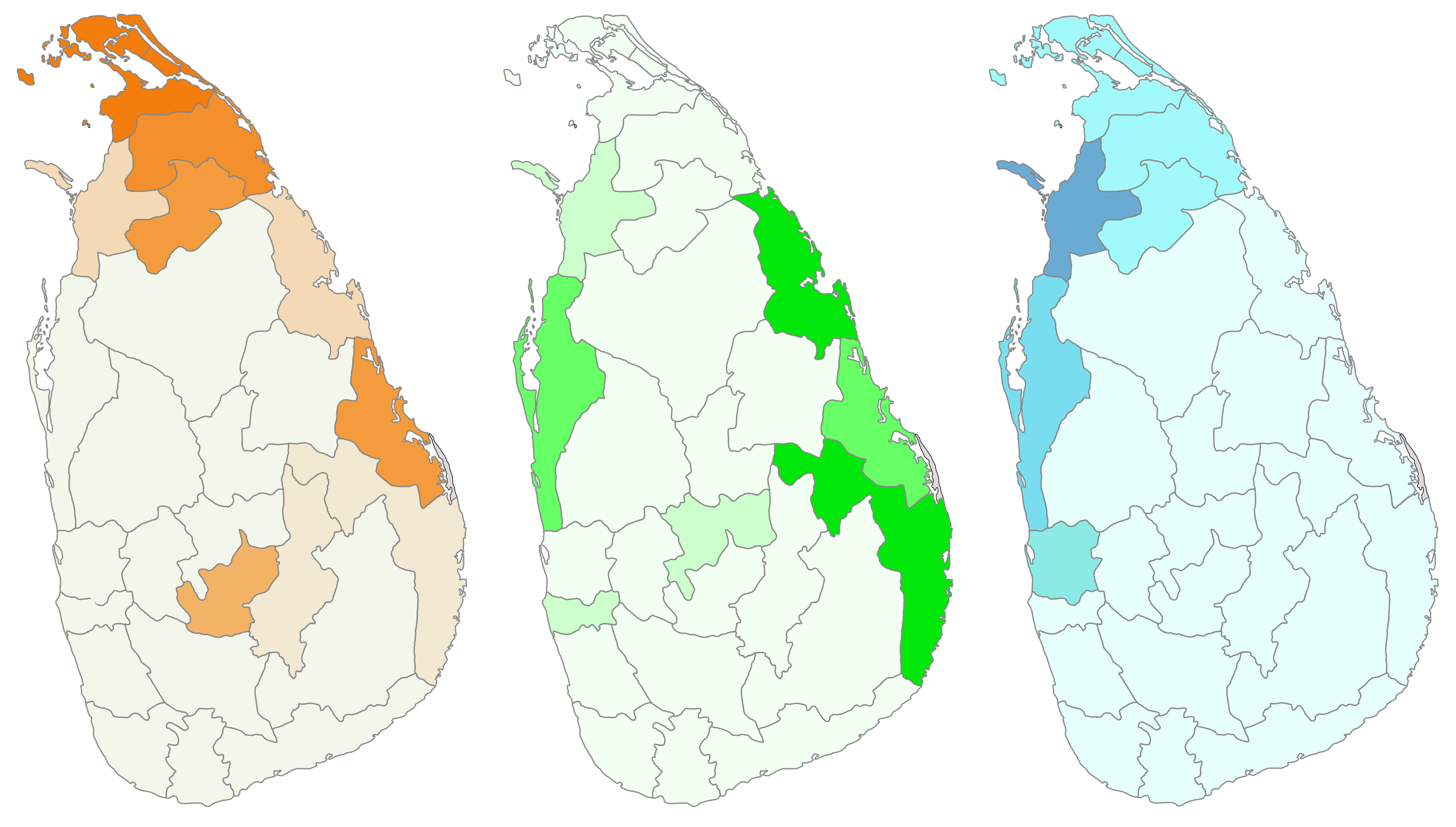
It turns out that Buddhism covers the entire island except for the coastal areas in the north and east. There is also a light area in the center of Sri Lanka where there are comparatively fewer Buddhists. All these areas are occupied by other religions, which create a semi-circle around Sri Lanka.
If we combine all religions on one map, we get a beautiful pattern:
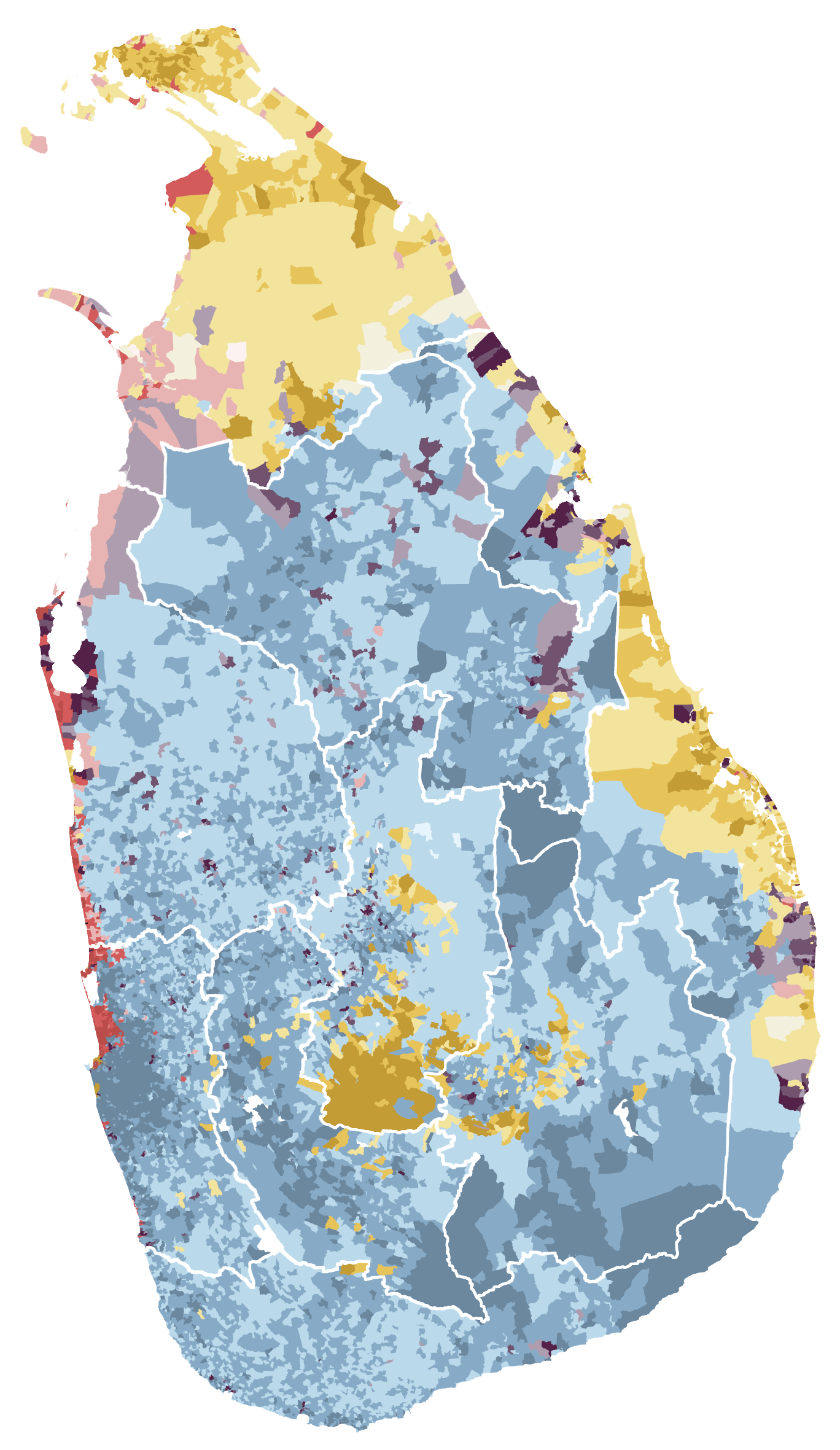
Now let’s take a look at the maps of ethnic groups and languages. It turns out that they coincide with the religion map. In the center of the island, except for the heartland, only the Sinhalese live. Tamils and other ethnic groups cover the island in a semi-circle from the north. The language map looks exactly the same.
It’s all simple because all Sinhalese are Buddhists, and other ethnic groups in Sri Lanka rarely practice Buddhism. Only the Sinhalese speak the Sinhalese language, while other ethnic groups speak Tamil.
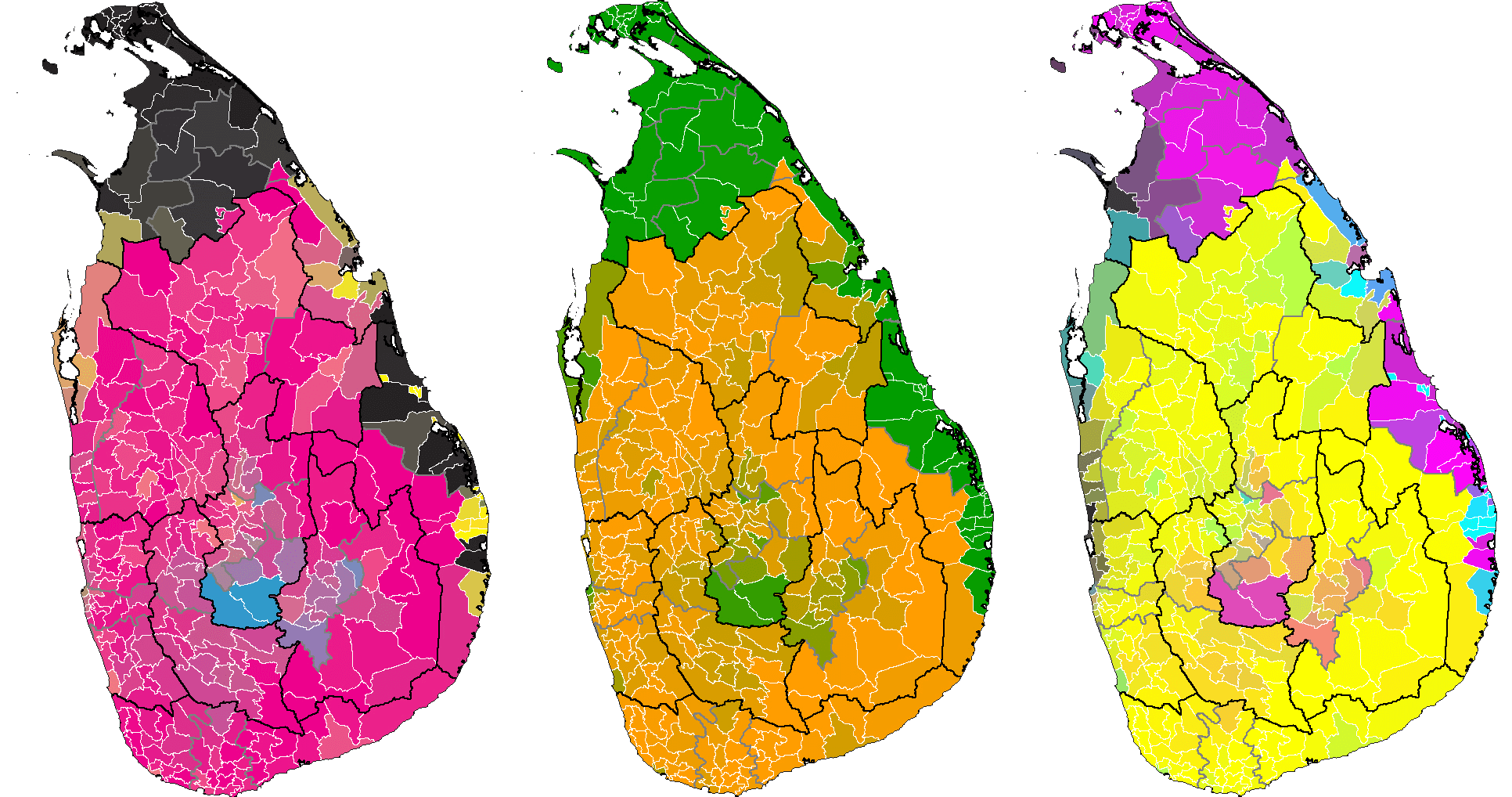
Now let’s take a look at how Sri Lanka votes in elections. Regions where the social-democratic party “National Front of Sri Lanka” won are marked in maroon color. Areas where the liberal party “New Democratic Front” won are marked in green.
It’s easy to guess that the maroon party represents the interests of the Sinhalese population, while the green party advocates for equal rights for all ethnic groups in Sri Lanka.
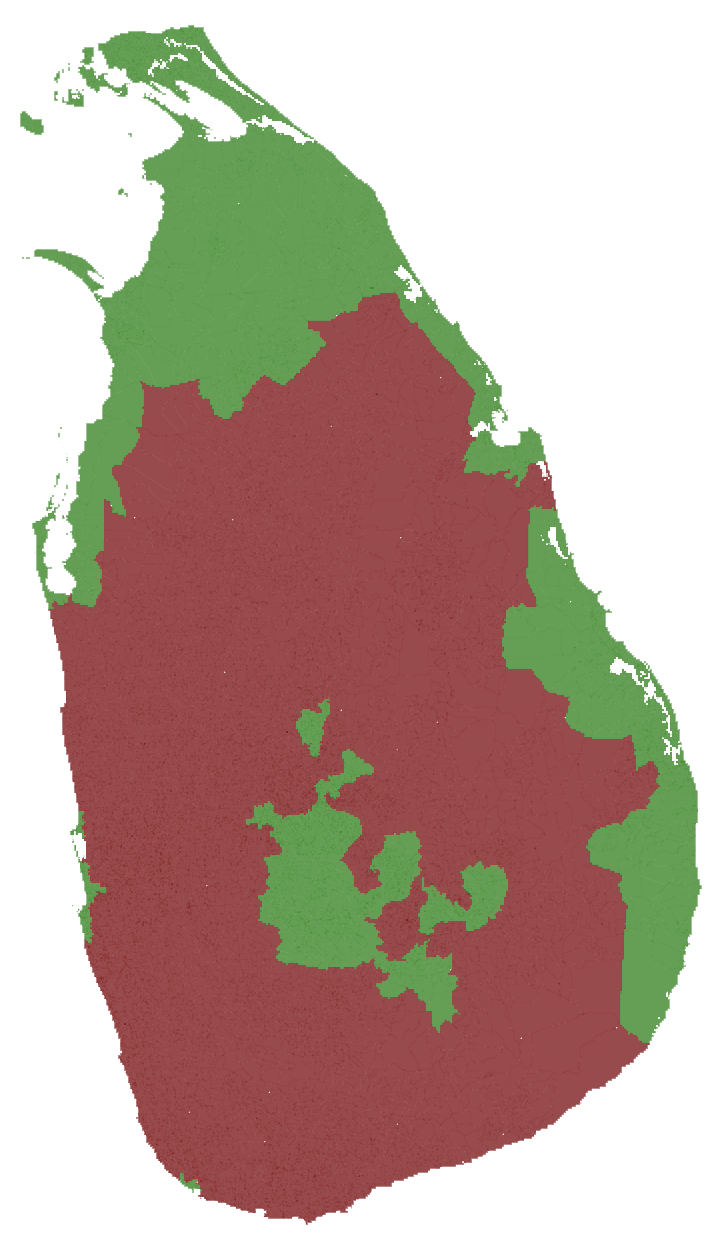
Now let’s compare the political maps with the geography of the island.
Sri Lanka is divided into three zones based on the amount of rainfall. The wet zone is located in the southwest of the island, where it often rains. Moving towards the center of the island, the rainfall gradually decreases — this is the zone of moderate rainfall. Finally, if you reach the outskirts of the island, you will enter the dry zone. Here it rarely rains, and the climate is much drier.
Look at how similar the rainfall map is to the map of religions and ethnic groups in Sri Lanka:
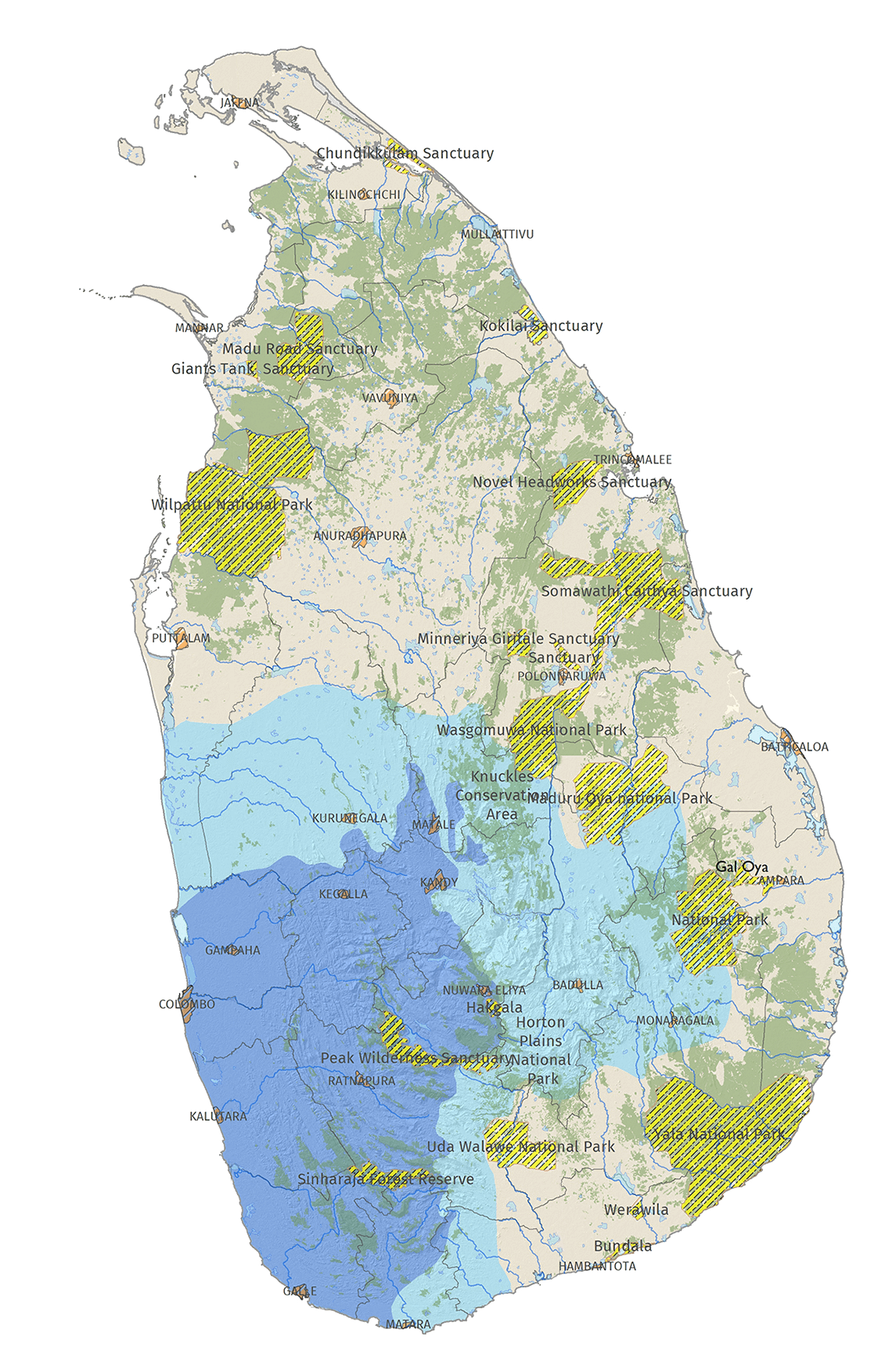
It’s interesting, is there any connection here? Most likely not, since the maps only match very loosely. However, there is definitely a connection between rainfall and the density of tea plantations:
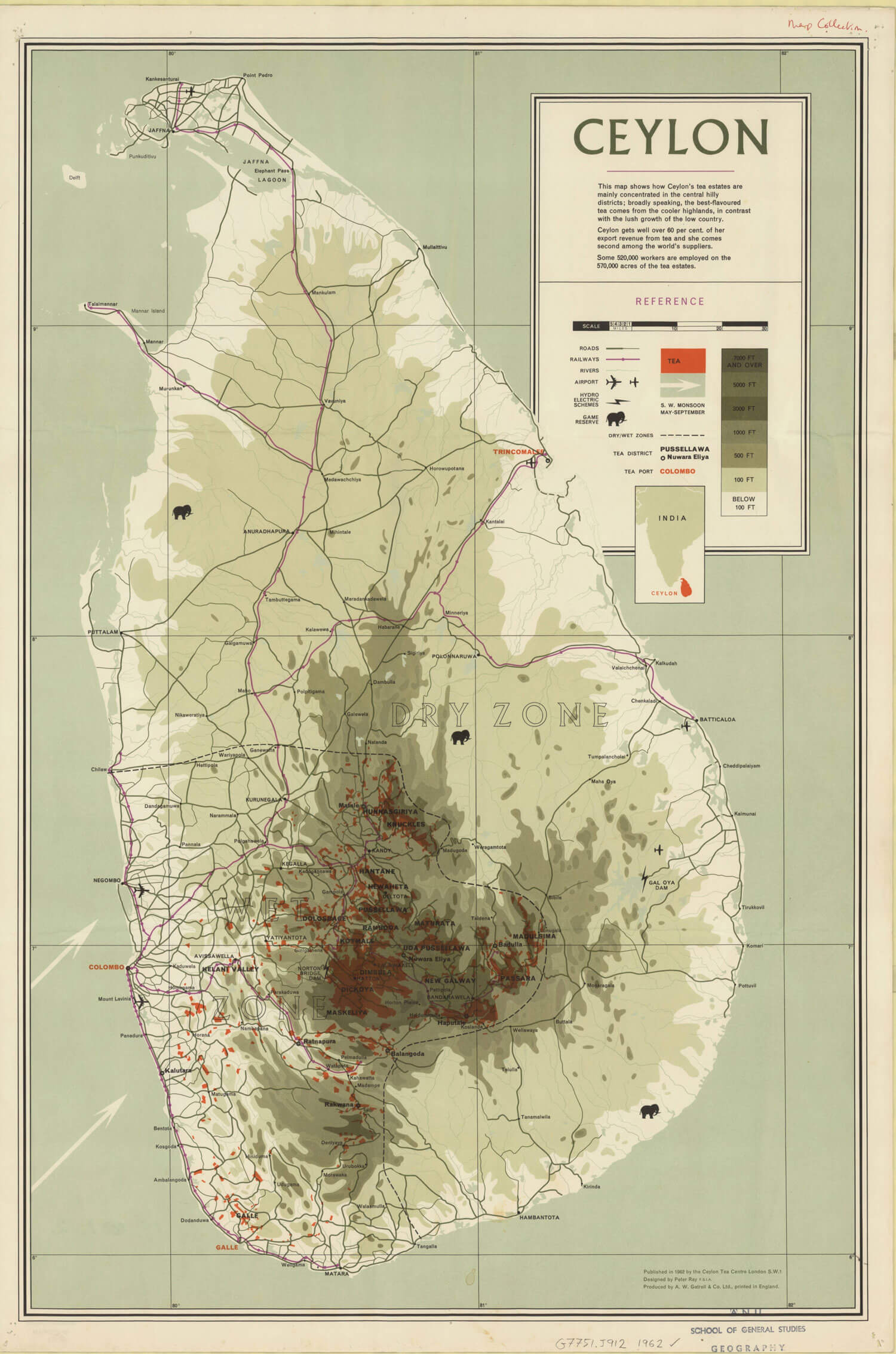
Moreover, the map of humidity coincides with agricultural regions:
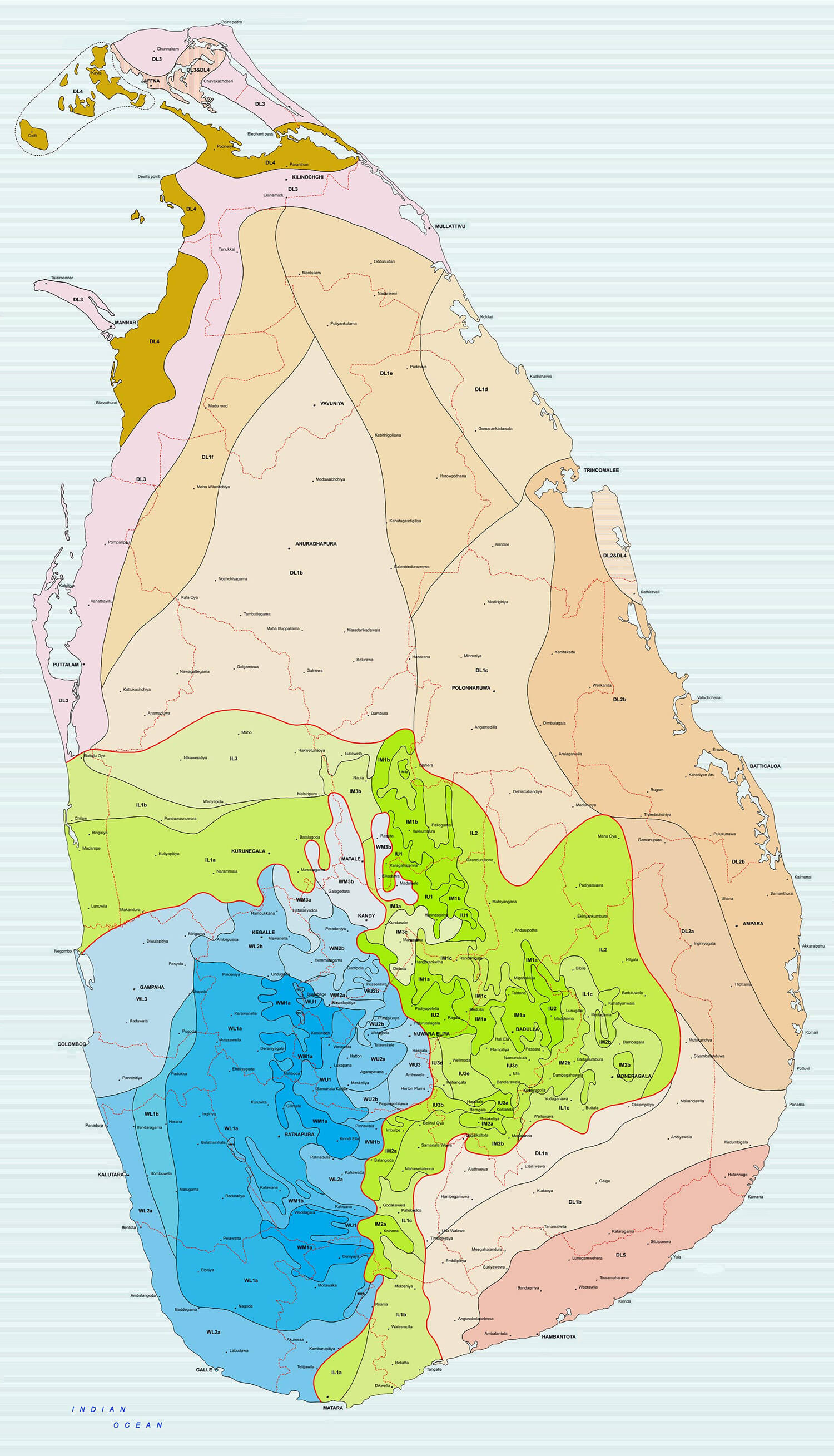
Maps of Sri Lanka are an excellent resource for studying the connections between geography, religion, and culture. The most beautiful map I’ve come across is a soil map. It has a genuine Indian pattern. Hang it on the wall if you like.
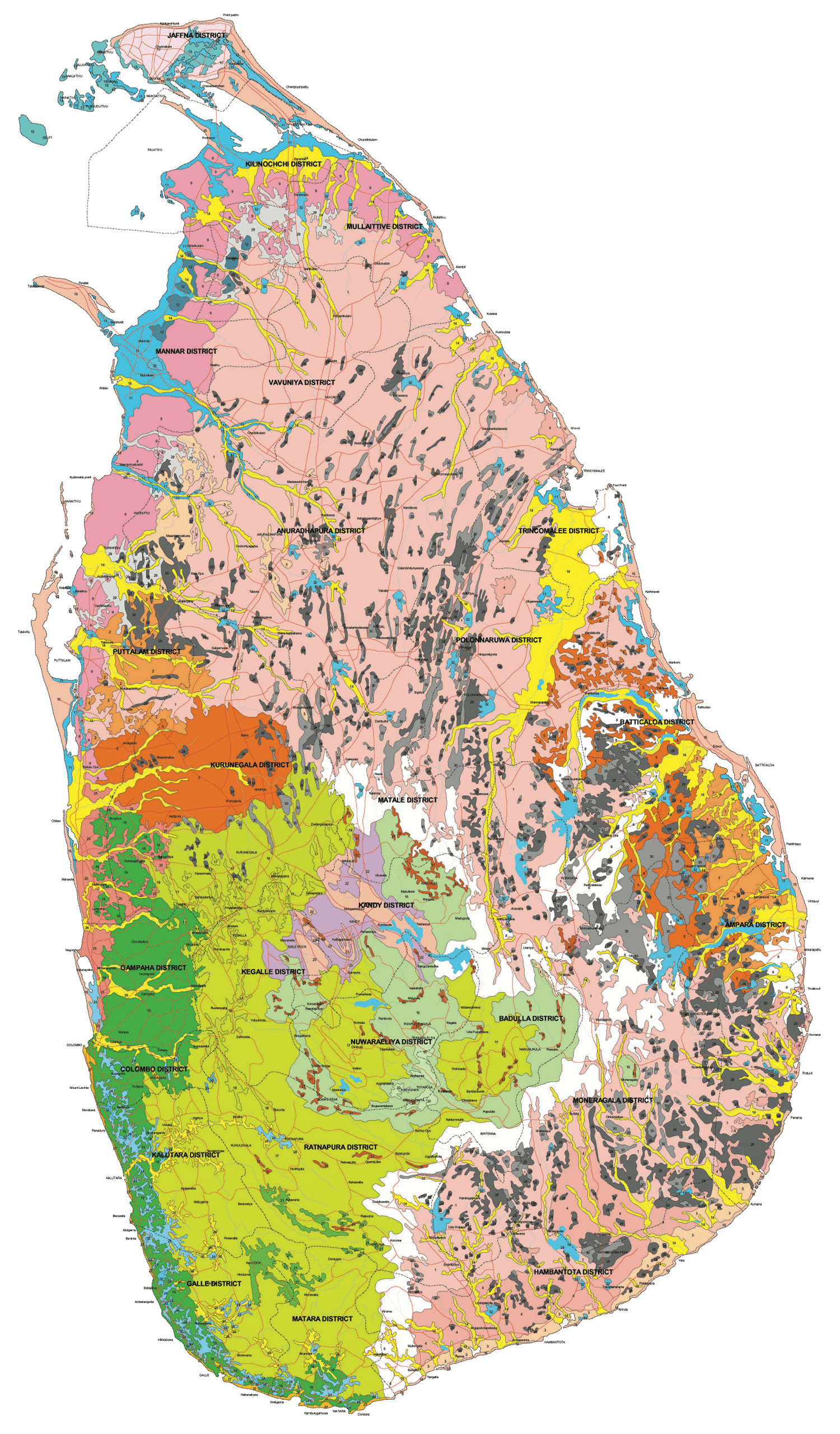
Thunder in paradise.
So, Sri Lanka is inhabited by four ethnic groups, although they can be reduced to two: the Sinhalese and the Tamils.
Indeed, all the ethnic groups in Sri Lanka speak either Sinhala or Tamil. And although we forget about the Moors, they can be conditionally attributed to Tamils: after all, it was on their side that the Moors fought during the civil war.
Yes, this lovely island in the Pacific Ocean was recently engulfed in a civil war.
The war was waged between the Tamils and Sinhalese. Everything was calm and boring until Sri Lanka remained a British colony. The locals toiled on tea plantations while the British built tea-processing factories and printing presses. Well, to print elephants on tea packaging.
The fun began when Britain relinquished its mandate over this colony and Sri Lanka became independent.
It turned out that the Sinhalese and Tamils were not evenly distributed on the island: the Sinhalese make up 75% of the population. As long as both ethnic groups remained British peasants, there were no problems. There were disputes over who harvested more tea, for example. Well, whoever gathered more would drink more.
However, the new, independent Sri Lanka, which had rid itself of colonial influence, had to harvest not tea, but its own government. It was then that the Sinhalese occupied the entire parliament, as there were more of them. And racial imbalance in the government is always a guarantee of ethnic problems.
And they did start. The first thing the Sinhalese did was to refuse to recognize Tamils as citizens of Sri Lanka. As a result, 700,000 people were left without citizenship. Of these, 300,000 were deported to India, and the rest became citizens only in 2003 — a whole 55 years after the war ended.
Then the Sinhalese made their language the only official language of Sri Lanka. As a result, tens of thousands of Tamils in the service sector lost their jobs because they did not know Sinhala. Then they got the taste and raised the passing score for universities, but only for Tamils. And so on.
All this moral humiliation was accompanied by regular pogroms of unfortunate Tamils with the support of the Sinhalese government.
Soon, the Tamils began to create guerrilla movements, which at first simply held rallies and then turned to attacks on Sinhalese policemen and officials. In 1975, numerous underground cells united into the Liberation Tigers of Tamil Eelam movement. Among the guerrillas was a good designer who drew a logo for the movement that was borrowed from Metro Goldwyn Mayer.
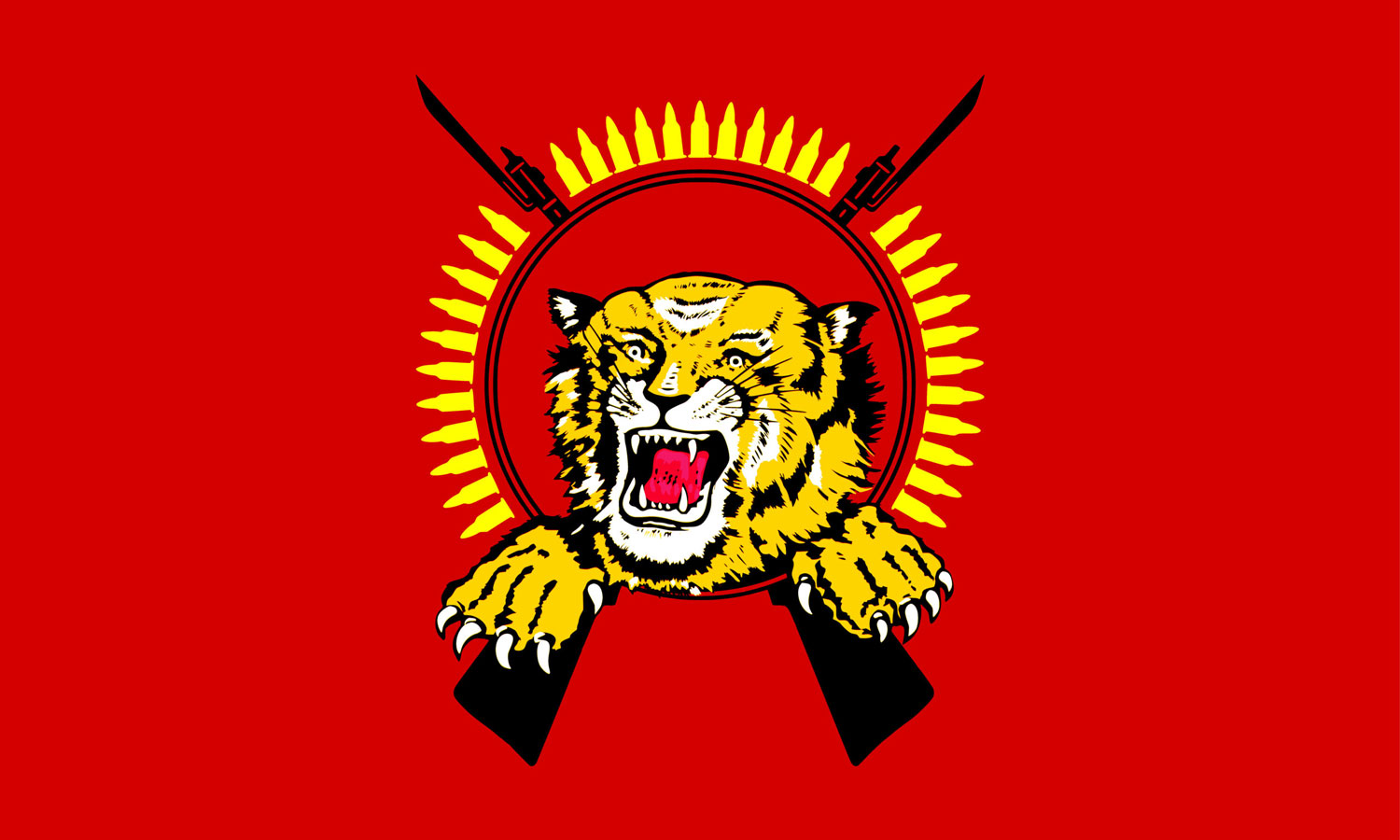
Aside from jokes, the Tamil movement quickly turned to terrorism. Of course, not without reason. Thirty years of humiliation on racial grounds!
The Tamils wanted to create their own state called Tamil Eelam. It was supposed to be located almost along the entire coastline of Sri Lanka — where mainly Tamils lived. Remember, we were looking at maps? Here’s another one:

Actually, the fighting took place in these regions. The trigger that started the hot phase of the war was a fire.
The Sinhalese, after reading Ray Bradbury, decided to set fire to the Tamil library. It contained the oldest handwritten scrolls, written on palm leaves. They succeeded in burning it down. The fire destroyed 90,000 books and took away a whole layer of history and culture.
The patience of the Tamils had run out. It became clear that it was a matter of genocide of the Tamil population and the destruction of an entire culture. Two years later, the guerrilla war officially became a civil war. The war in Sri Lanka lasted for 26 years: from 1983 to 2009 — and claimed the lives of 100,000 people.
Interestingly, during the course of the war, the Sri Lankan government increasingly accommodated the Tamils. Discrimination stopped, and citizenship was given to all who wanted it. Thus, gradually, the “Tamil Tigers” turned from freedom fighters into terrorists, as their attacks on civilians did not stop.
Everything ended in 2009, when government forces eliminated the last leader of the Tamils. Since then, Sri Lanka has calmed down, although terrorist attacks still occur occasionally. And not much time has passed: 13 years of peace against 26 years of war.
Default.
Having already returned home, I learned that I had actually been in a socialist country. The full name of the country sounds like this: Democratic Socialist Republic of Sri Lanka.
That’s when everything fell into place!
Sri Lanka had barely recovered from the civil war when the coronavirus came. The country suffered greatly from the quarantine. Sri Lanka has always relied heavily on tourism, and now tourism has stopped.
Even before the quarantine, Sri Lanka was facing a crisis. The country was barely making ends meet. The treasury did not have enough money to pay for oil to generate electricity, and then a drought occurred, causing hydroelectric power stations to stop working as well. As a result, for a whole month in 2019, the entire country had to endure four hours of daily power cuts.
And what happened after the quarantine! The influx of currency into the country completely dried up, and even withdrawing dollars from ATMs was prohibited. But it didn’t help. They had to cut off the electricity again, first for an hour, then for two, and then for three hours a day.
When I arrived in Sri Lanka, the entire island was experiencing five-hour power cuts every day. Strangely enough, it wasn’t a big problem for me. I worked from my laptop, which could easily last a whole day, and the mobile internet was sufficient for all tasks. The main discomfort was that we couldn’t turn on the air conditioning. With 100% humidity and constant heat of 33 degrees Celsius in Sri Lanka, it was unpleasant.
Gradually, other problems were added to the power cuts. Banks began to falter, resulting in huge queues for cash withdrawals. Then queues appeared at gas stations. The cost of oil had risen so much due to the war in Ukraine that poor Sri Lanka simply ran out of gasoline.
“Big deal, they’ll save on gasoline,” I countered the sufferings of one Sri Lankan.
“Bro, the boats also run on gasoline. They can’t fish now, soon there will be nothing to eat.”
And it was true. Although fish was available, food began to disappear from stores. The hardest thing to find was milk. It was simply swept off the shelves on the day of delivery. Only vanilla and strawberry milk remained. I tried eating corn flakes with it and making pancakes. It was somewhat disgusting, but edible. However, another week passed, and even the strawberry milk disappeared.
Perhaps that’s why Sri Lankans were so interested in the war Putin unleashed in Ukraine. Many hung Ukrainian flags on their tuk-tuks. Someone hung the Russian and Ukrainian flags together in their office. And everyone, without exception, upon learning that I was Russian, asked:
“So, how’s it there?”
“It’s awful, friend. War is going on.”
“Why did he start it? Wasn’t COVID enough for him?”
“We’re shocked ourselves. We hadn’t recovered from the epidemic, and now there’s war.”
“Everyone in Sri Lanka is talking about it. We all watch the news. Yesterday they shelled a theater in Mariupol, where people were hiding. Three hundred people were killed. For what?”
“I don’t know. He’s just gone mad.”
“How can this be... you were one country before. Why do you need to fight? We in Sri Lanka know well what war is.”
Yes, the war explained why there were queues for gasoline. But why were food products disappearing? I didn’t immediately understand that prices are regulated in Sri Lanka. It turns out that the ex-factory price is written on each package. There are also price tags in stores, but no one looks at them. They are obliged to sell at the price indicated on the package.
That’s it! It was a shortage of goods, just like in the USSR.
If the government did not regulate prices, milk would simply have doubled in price but not disappeared altogether. And if prices cannot be raised, selling goods becomes unprofitable, and stores stop stocking them.
Remembering the black market trade in the Soviet Union, I thought that there must be milk somewhere. And indeed, all I had to do was not go to a supermarket but to a private shop. They sold me milk, which they brought from some barn. It was twice as expensive and no more than two packages at a time. You can’t cheat the economy!
However, I didn’t have time for milk anymore. In the last days of my stay in Sri Lanka, they started cutting off electricity for ten hours a day! Working became impossible due to the constant heat. I talked to a Sri Lankan man then, who, by the way, was selling excellent weed:
“Douglas, what’s up with the electricity?“
“There’s no money for fuel, and there haven’t been any rains for a while.”
“And how long will this last?”
“I don’t know. But we’re planning to overthrow this government.”
After a week, protests began. The government imposed a curfew, although it was not observed in Hikkaduwa. Electricity began to be cut off less frequently, but no one cared anymore. An angry crowd stormed the government building and went for a swim in the pool at the Central Bank.
The Sri Lankan government declared default and resigned. The president fled to the Maldives.
Life after death
Sri Lankans are an intelligent and cultured people. They are also very cheerful.
It’s impossible to walk down the street without someone smiling at you. In this culture, as in many Asian countries, it’s customary to respond to eye contact with a smile and a wish for a good day. As soon as you look up at someone passing by, they will smile and say, “Hello!” And you’ll smile back at them. Not on the first try though.
Sri Lankan men wear a traditional garment called a sarong. Women wear a sari dress, like in India.
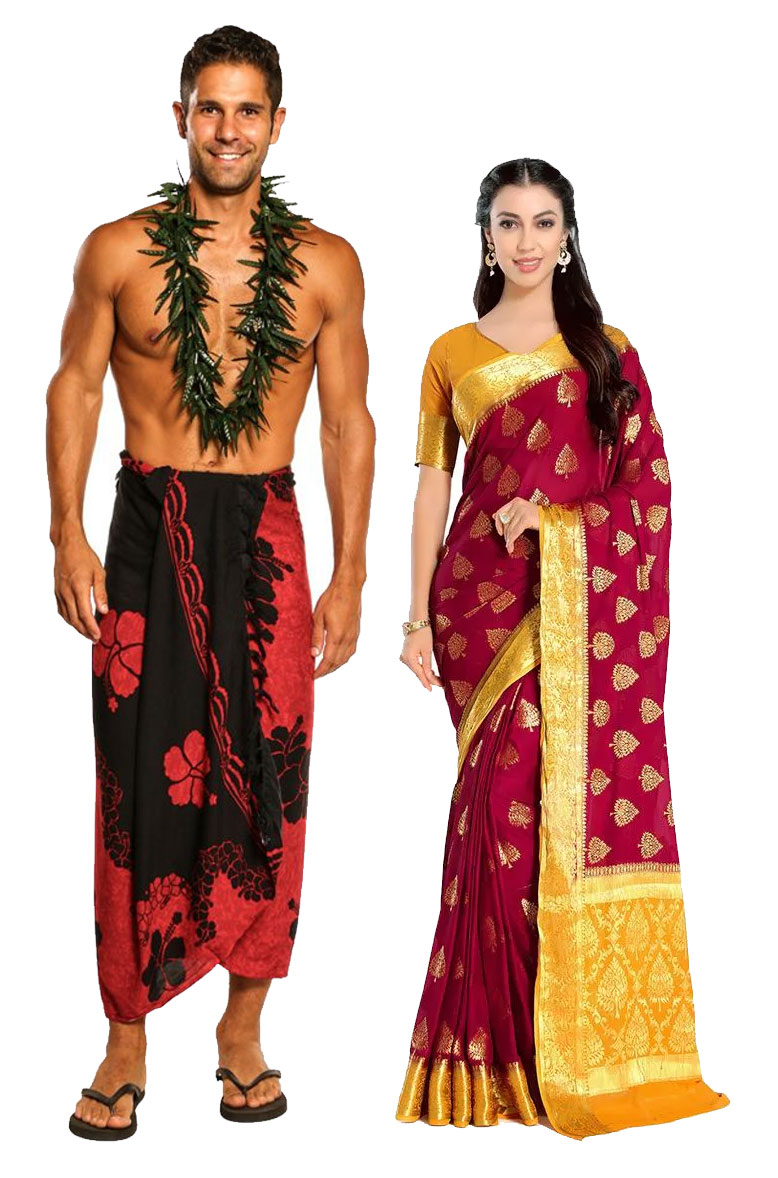
In Sri Lanka, products are purchased either at the market, in small stores like Selpos, or at supermarkets. The Cargills supermarket chain was founded as early as 1844 and has long enveloped the entire island. It’s a modern store similar to those in Europe. I even initially thought it was a British chain.
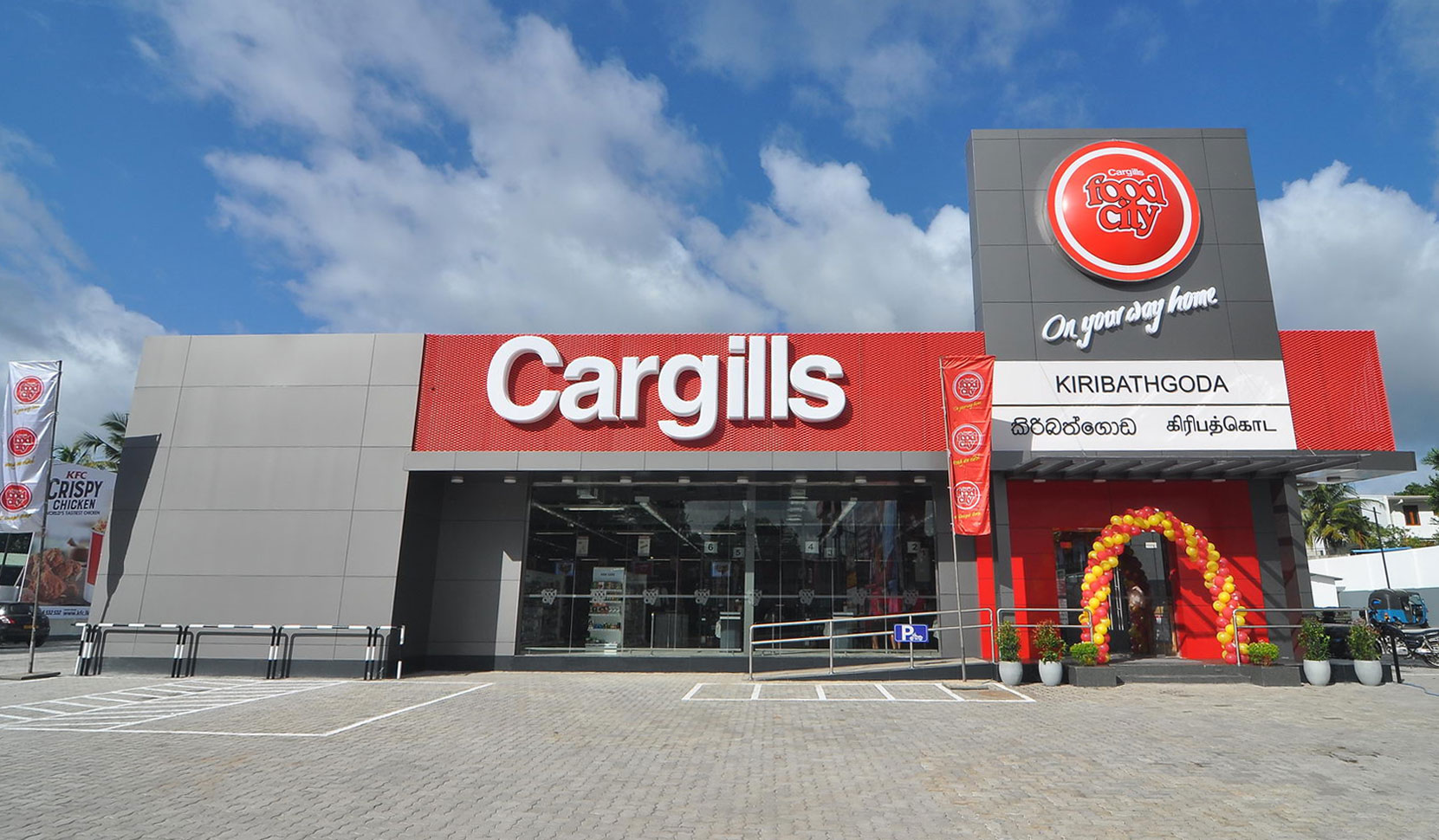
Sri Lankans use all types of transportation. The most cursed of them all is the motorized rickshaw called a tuk-tuk. These damn things occupy all the roads, they’re loud and annoying. When I visit all the countries that have tuk-tuks, I’ll breathe a sigh of relief.
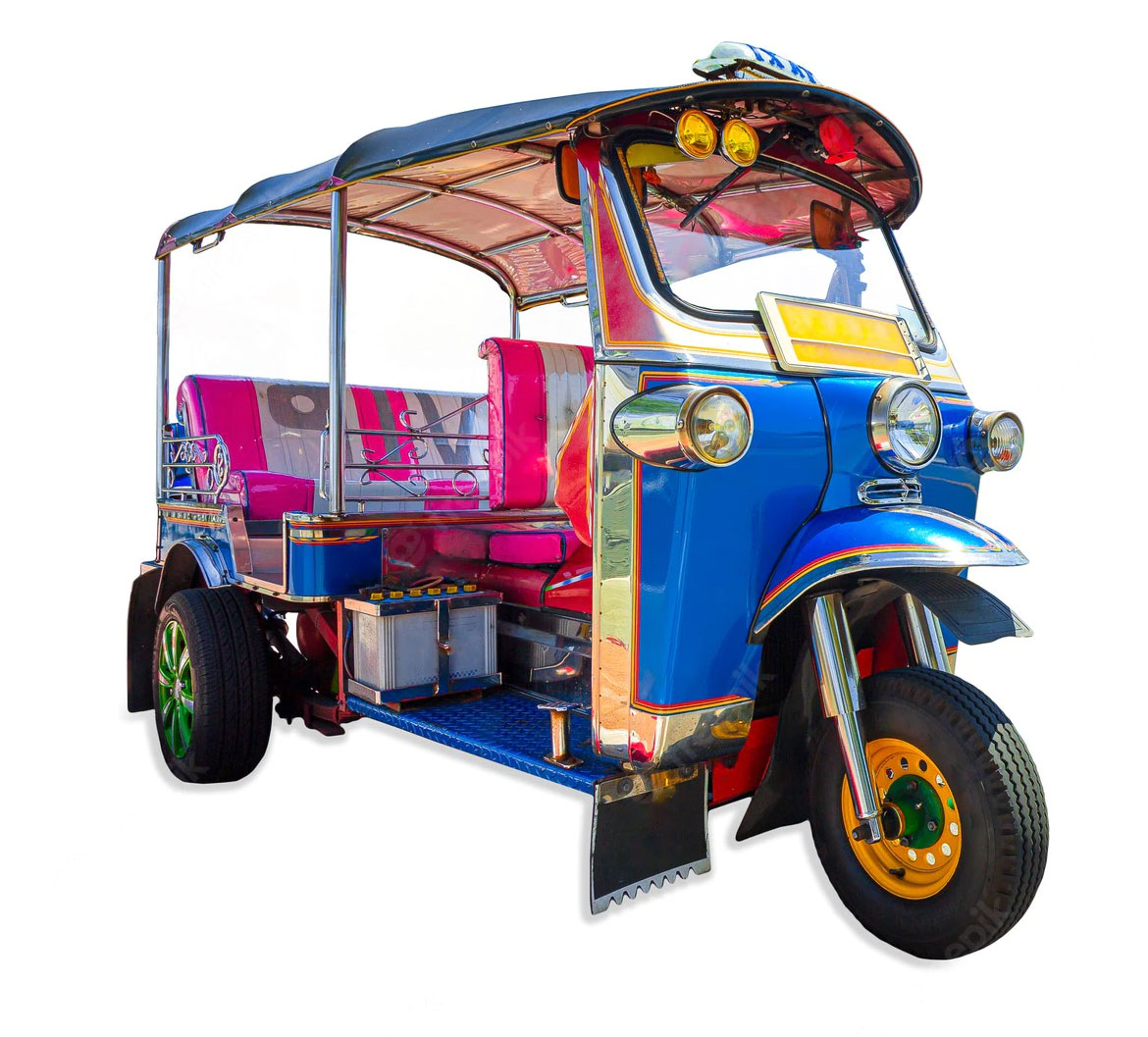
Buses in Sri Lanka are called “crazy buses” by locals, and they really are crazy. Inside, there are portraits of Shiva and loud music playing. At night, the whole cabin is lit up. Buses drive like maniacs, disregarding all rules. I was hesitant to ride them for a long time because there’s no air conditioning inside. It turned out that it’s not needed: the bus speeds so fast that there’s a ten-point storm inside the cabin.
Trains in Sri Lanka are ordinary. They’re similar to Indian trains, but not as run-down. They move slowly, are often delayed, and always overcrowded.
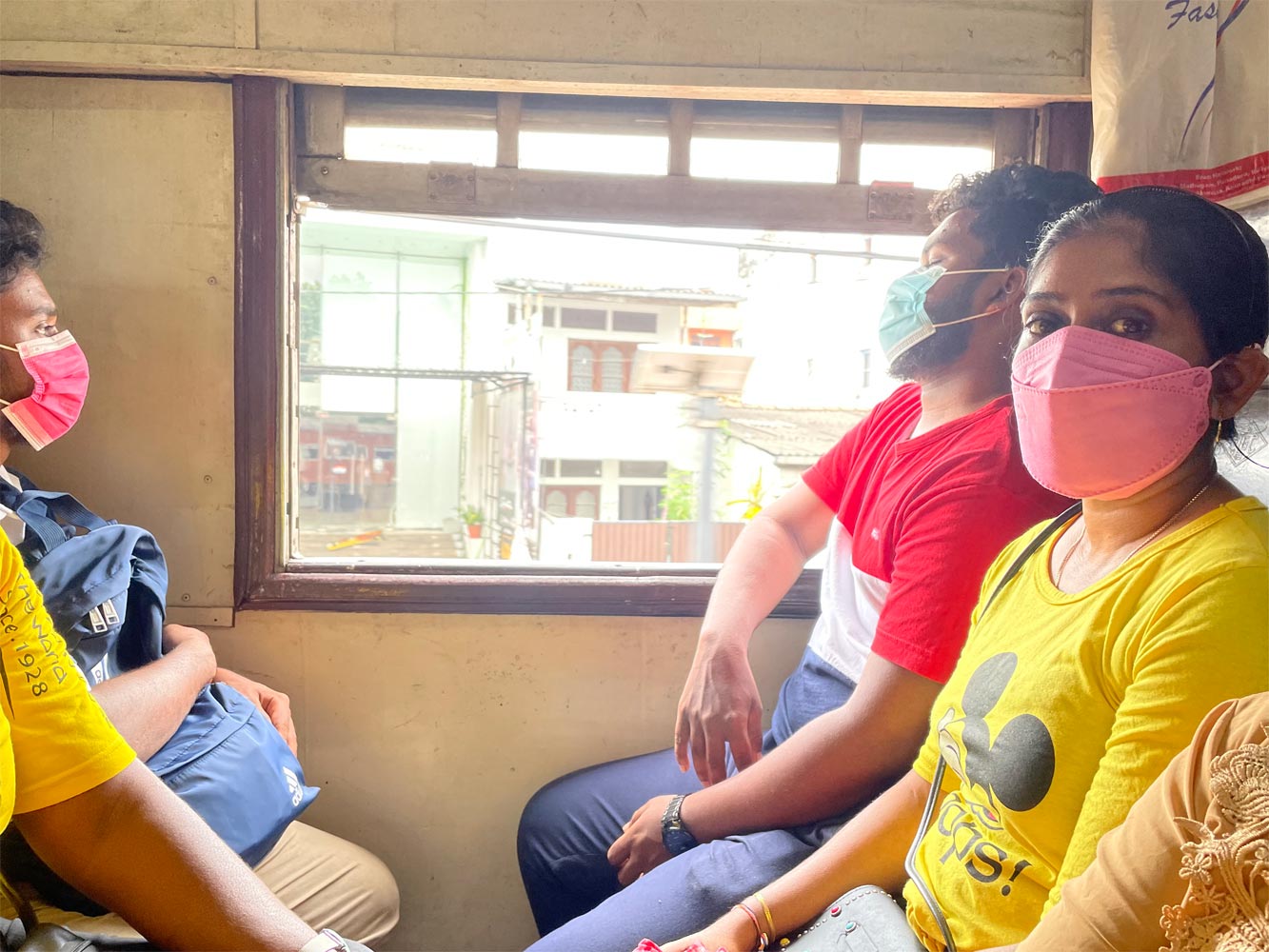
The most popular religion in Sri Lanka is Buddhism. There’s much less Islam, and one needs to travel to the northern part of the country where Tamils live to find it. In Buddhist regions, statues of Buddha stand on every corner in glass boxes. They light up at night.
Well, what else to say about this country? I want to believe that there’s life after death. Sri Lanka needs to get rid of socialism and introduce market prices. Maybe then everything will somehow fall into place on its own. Or maybe not.


